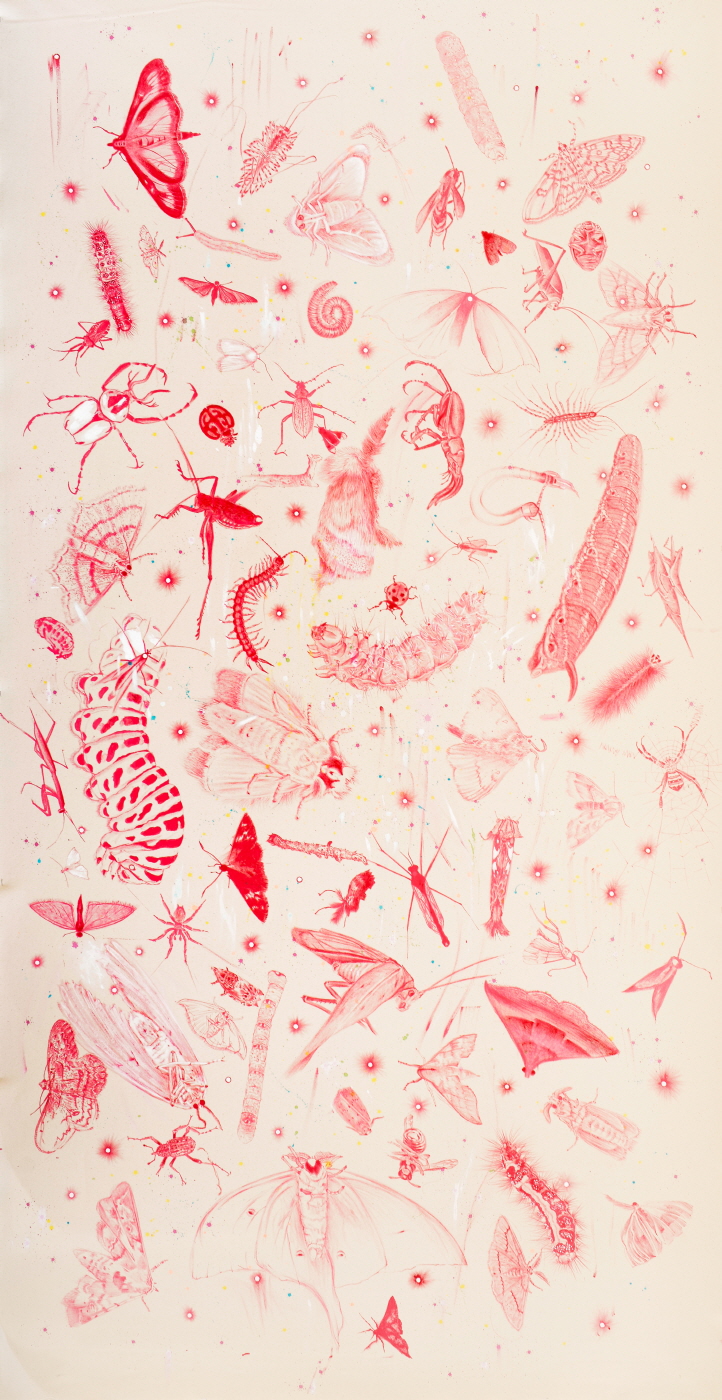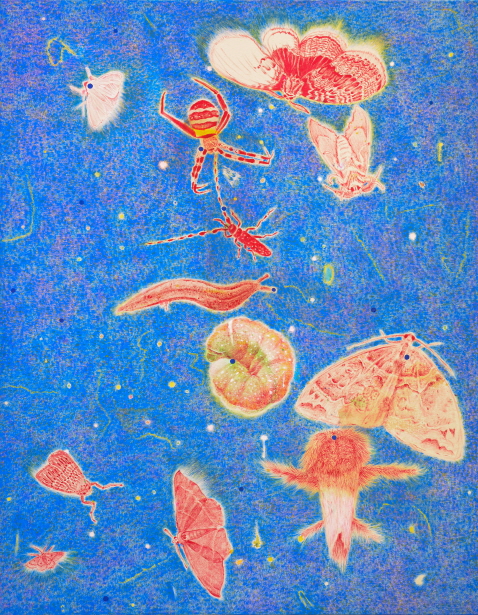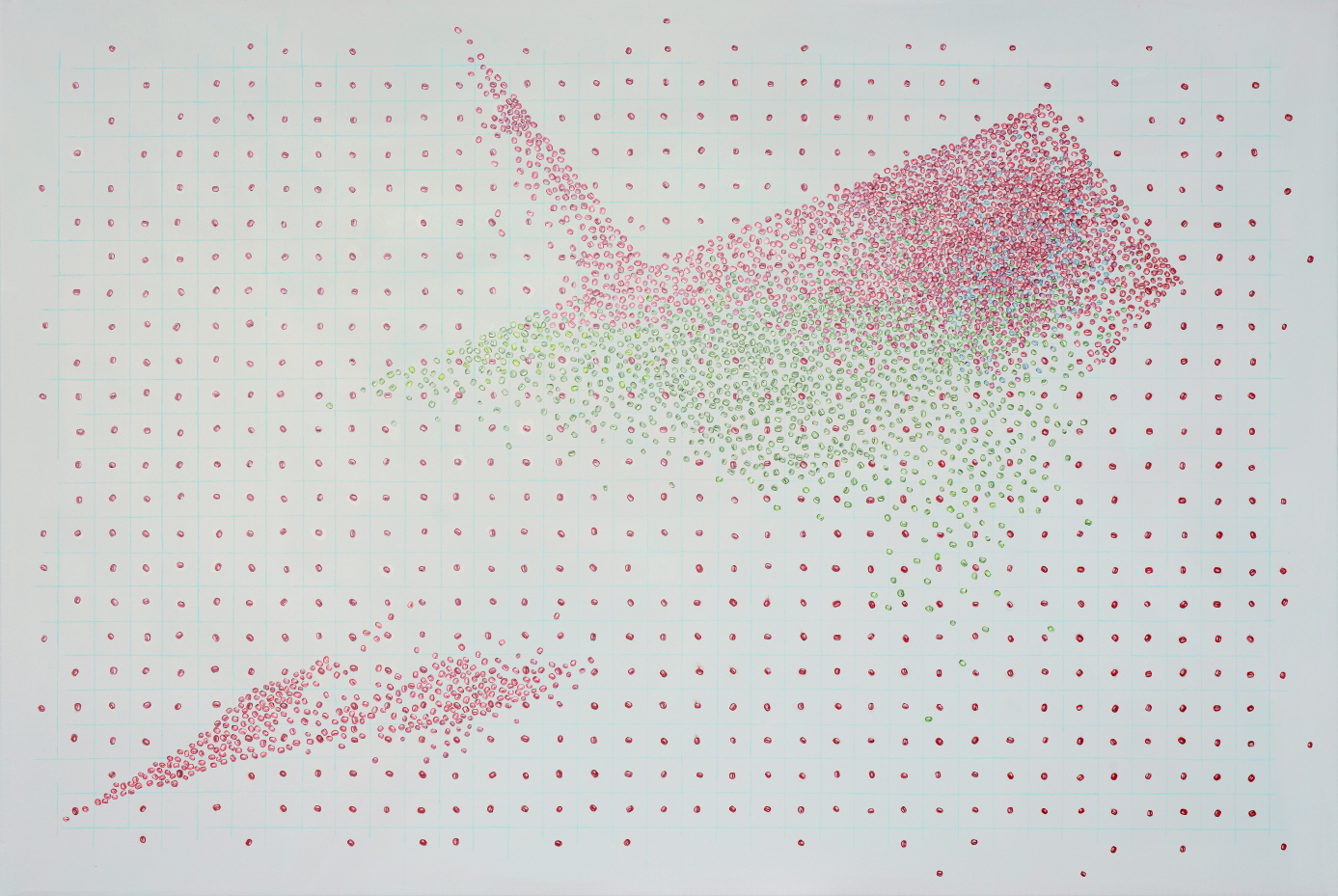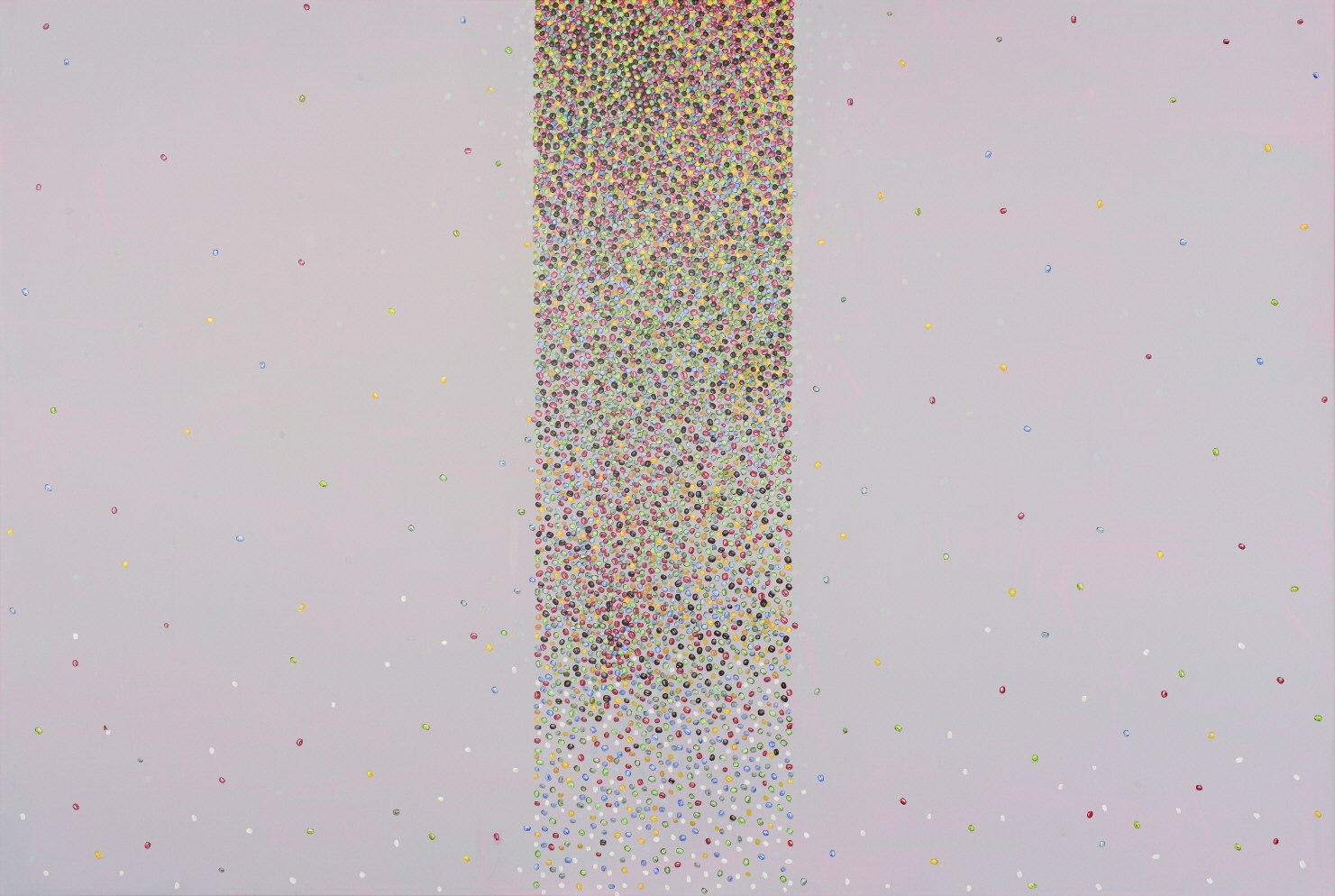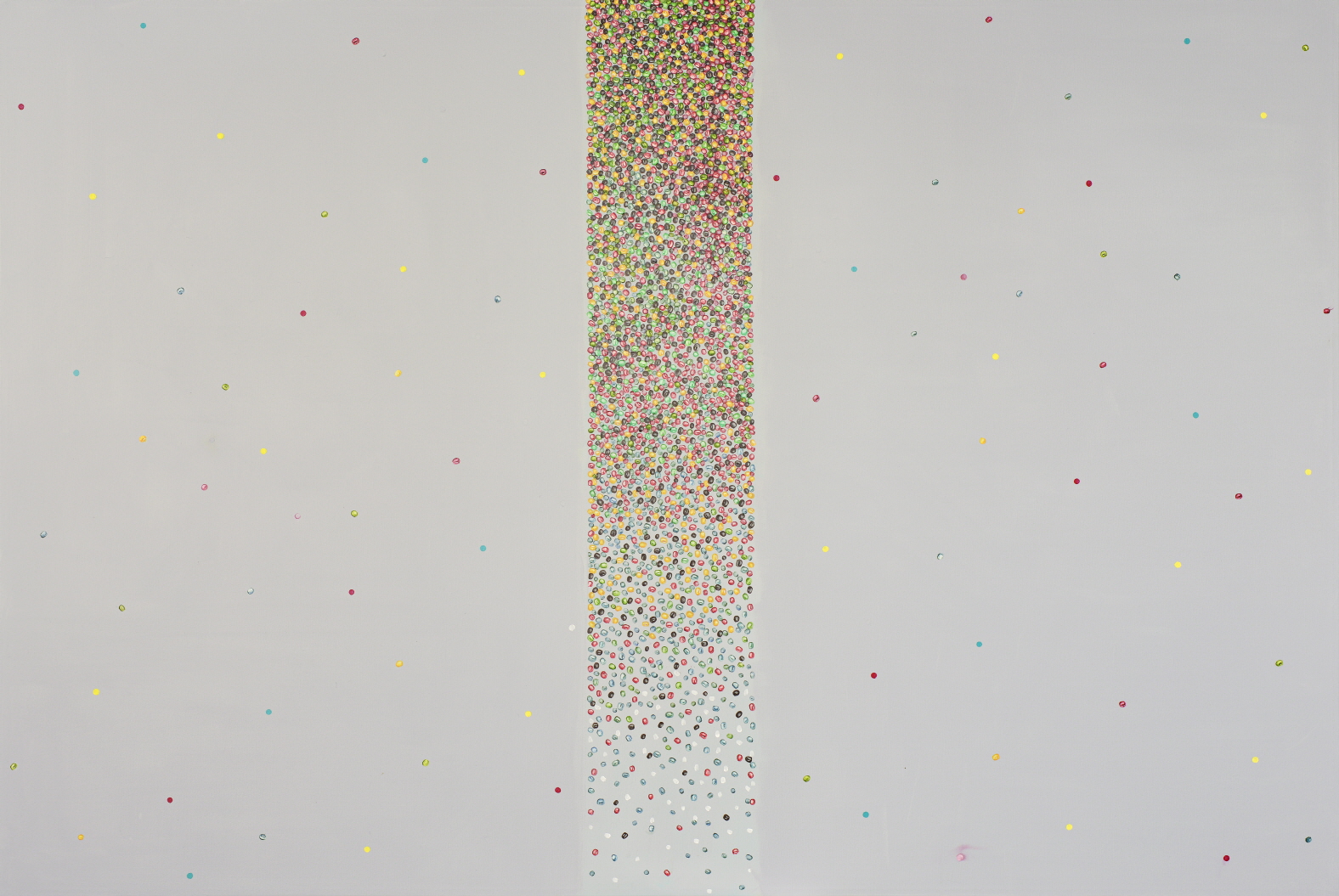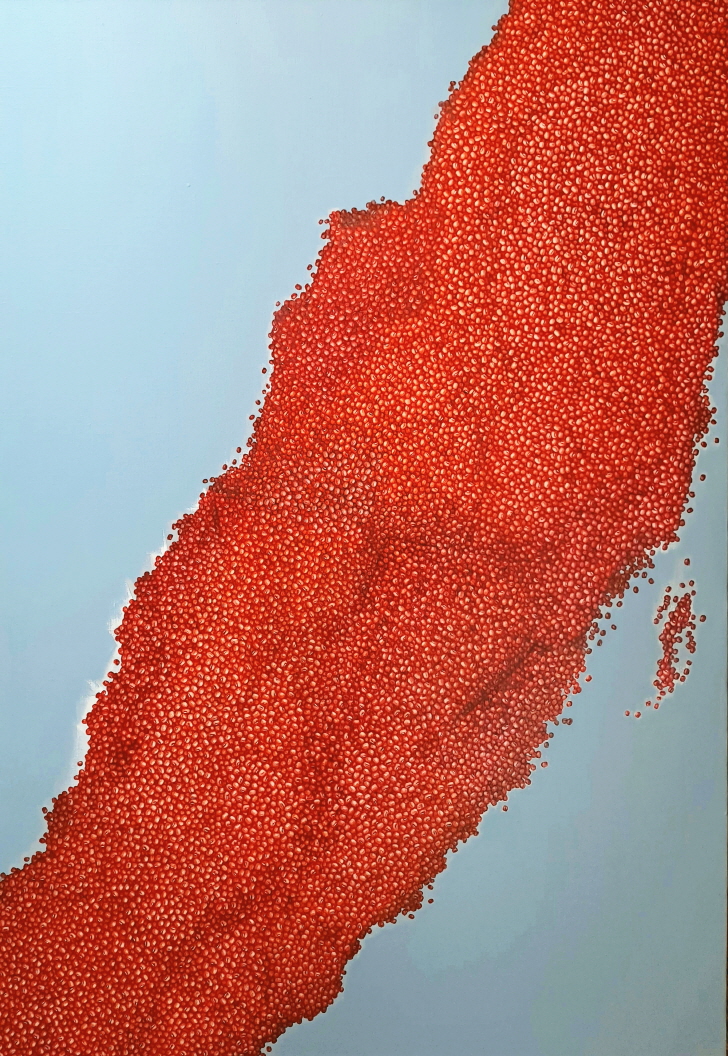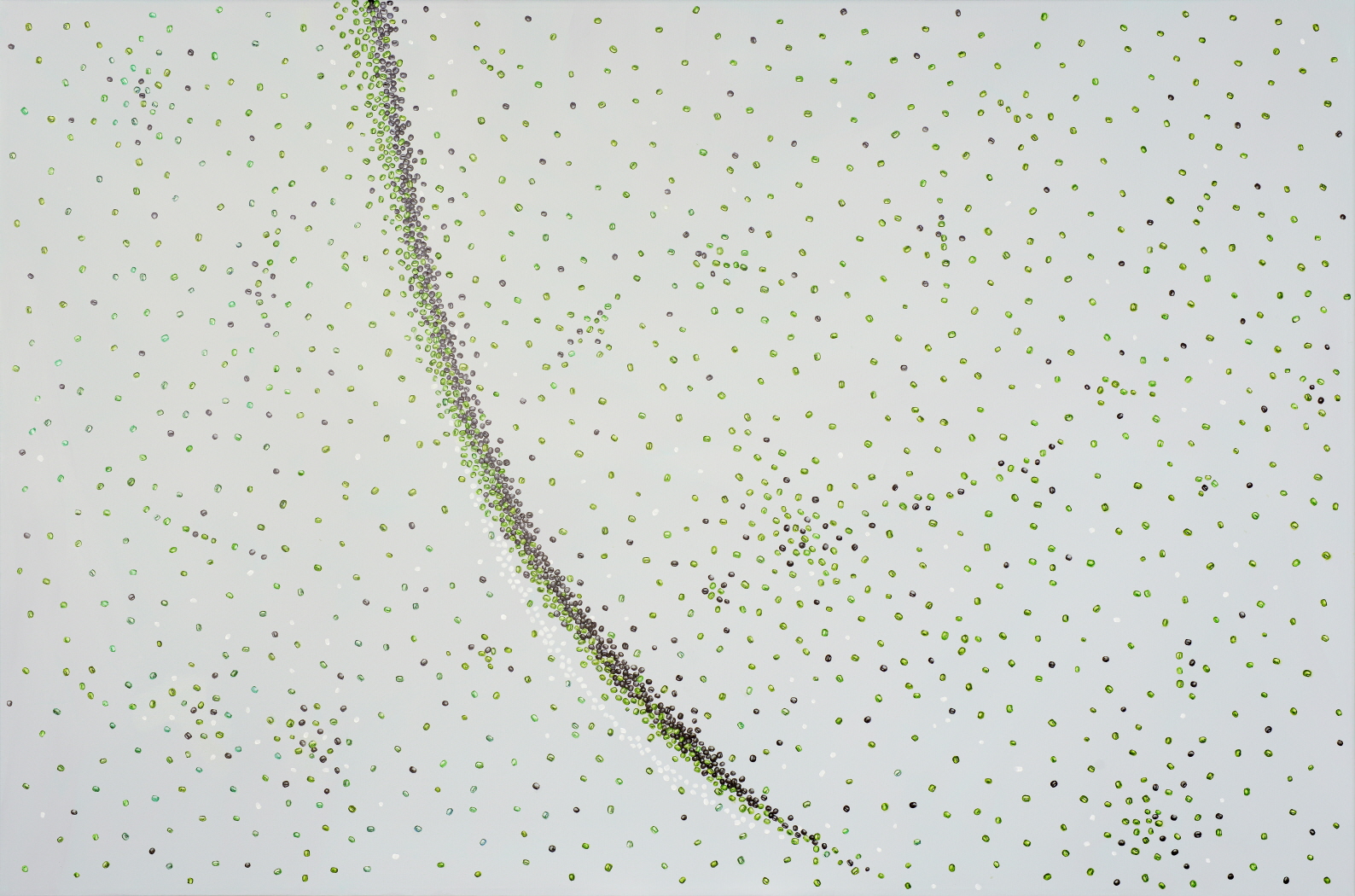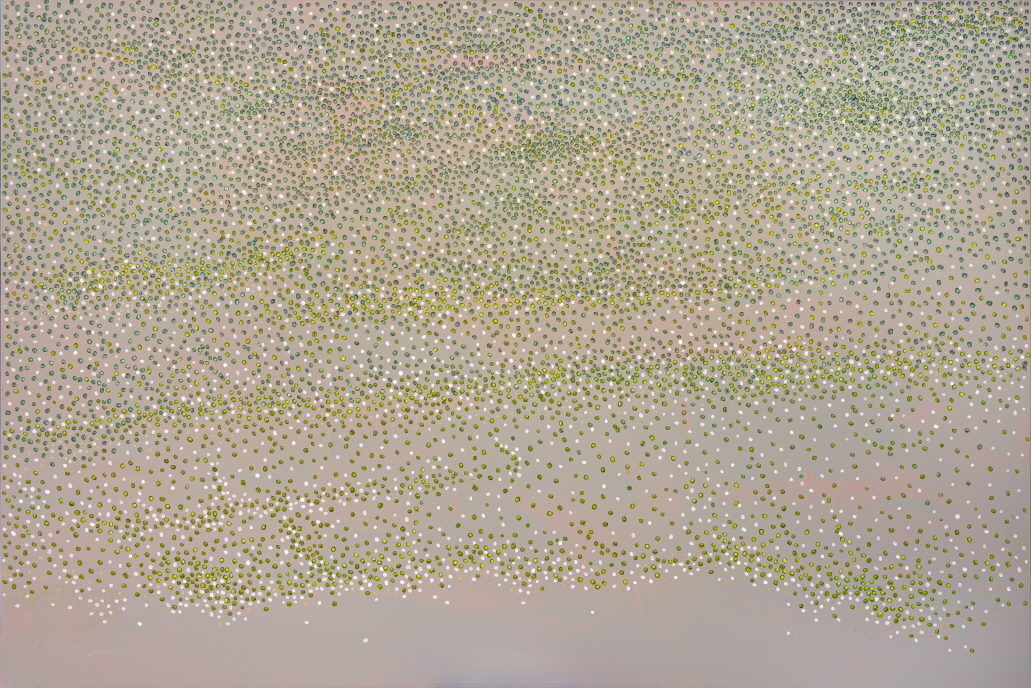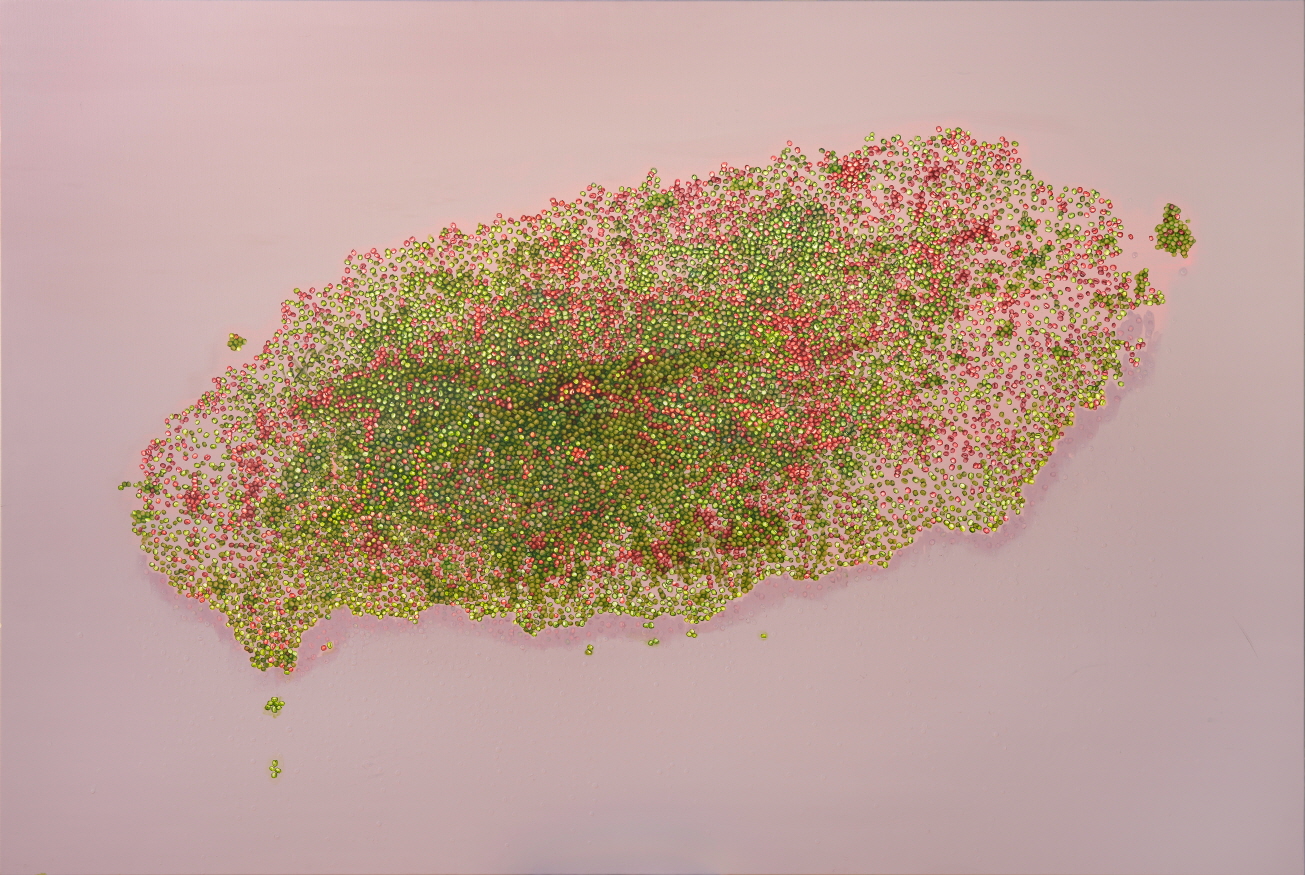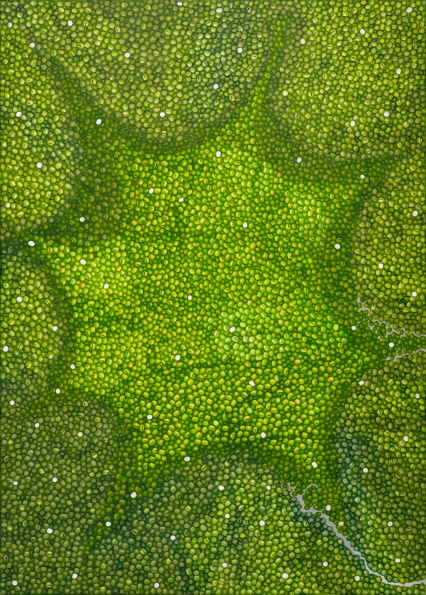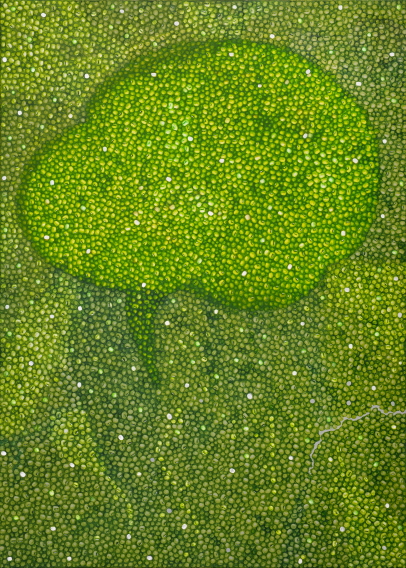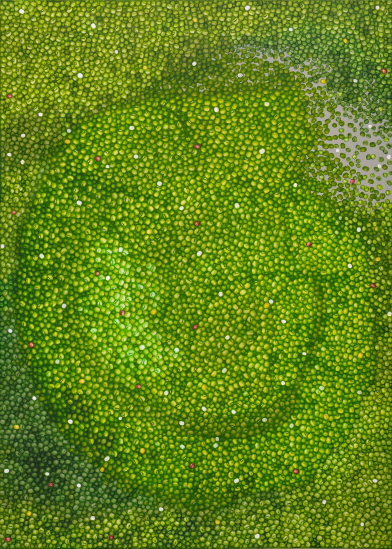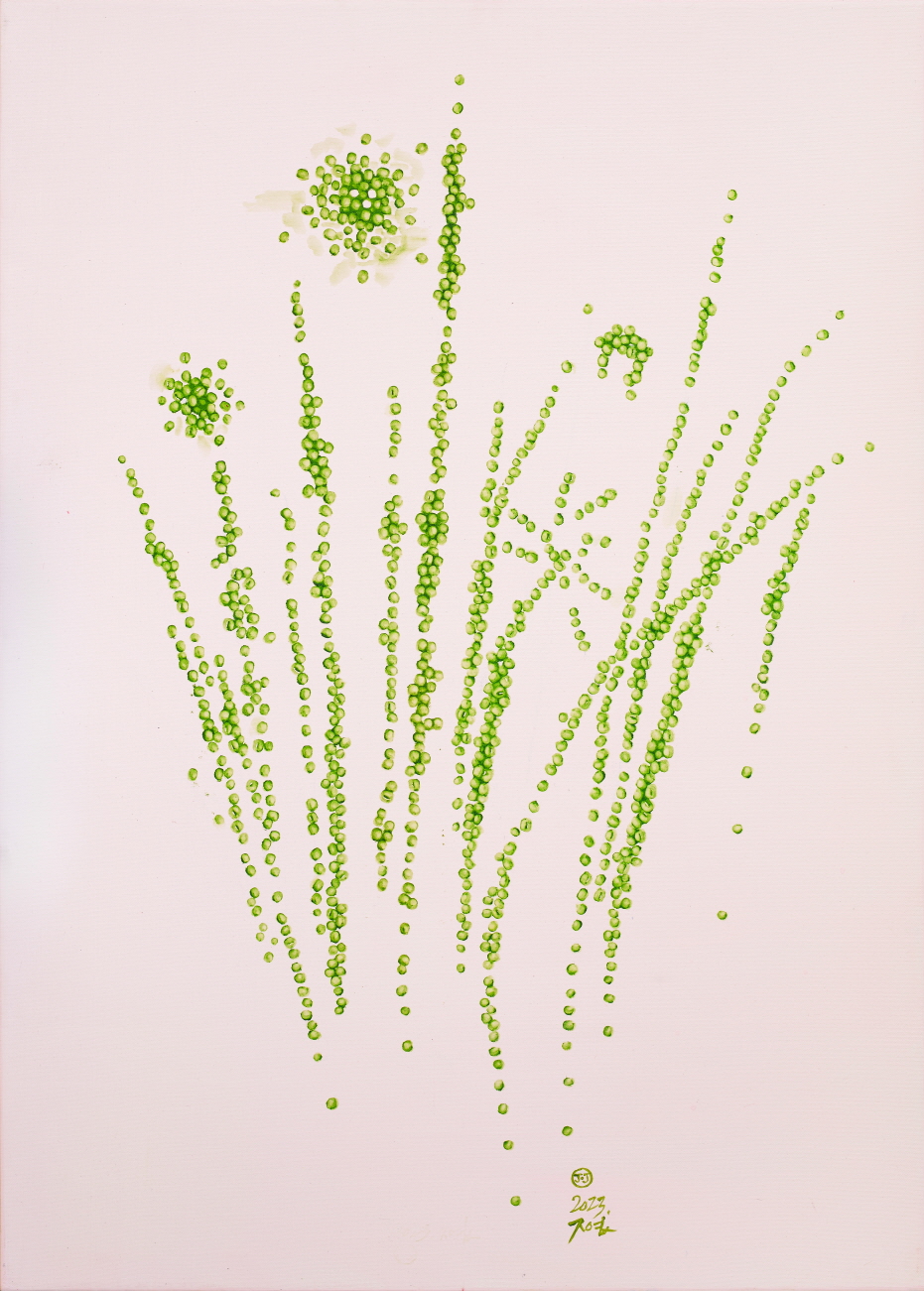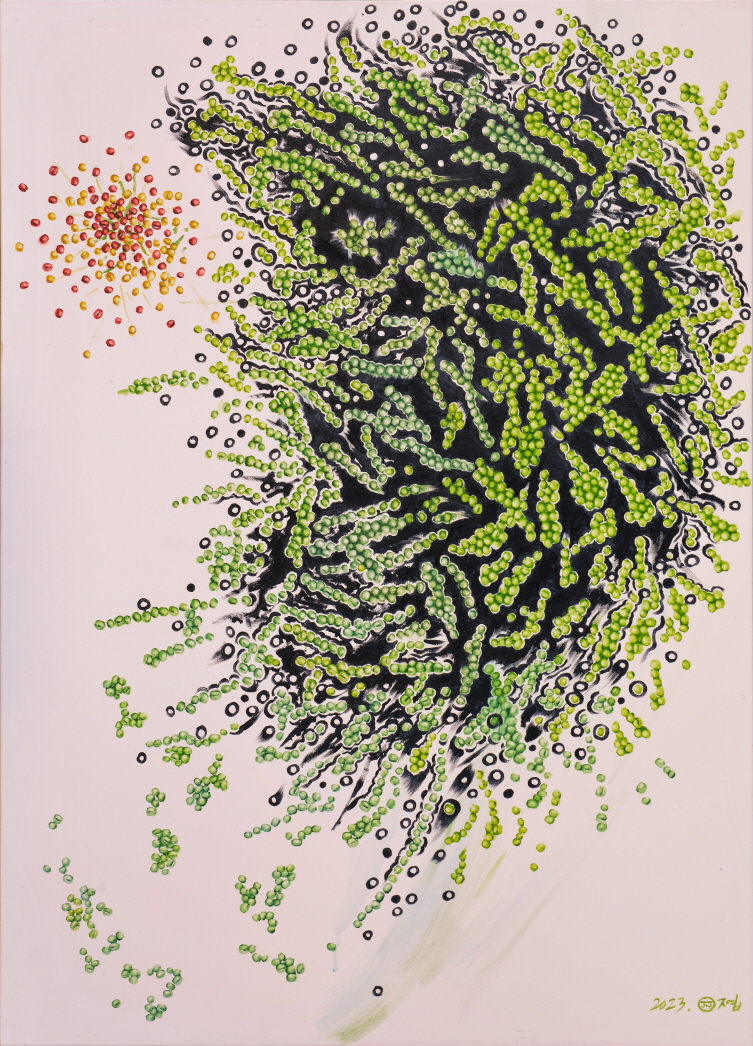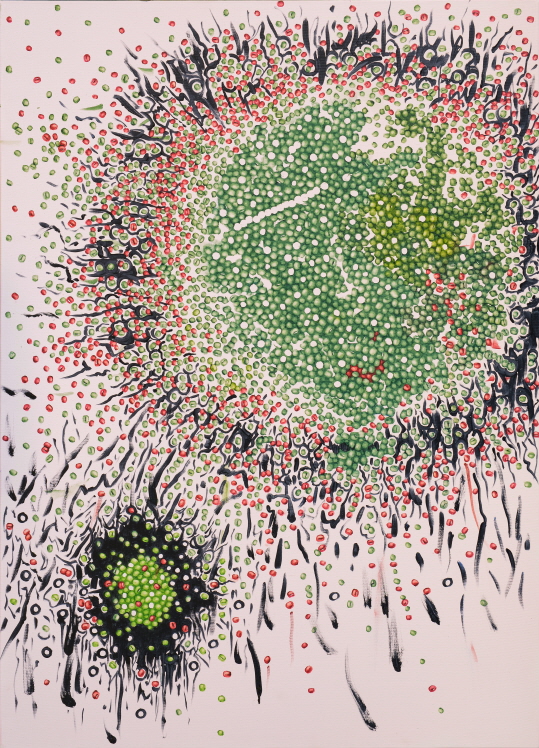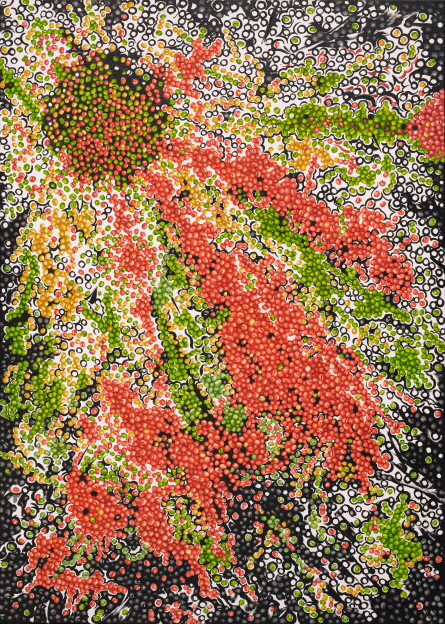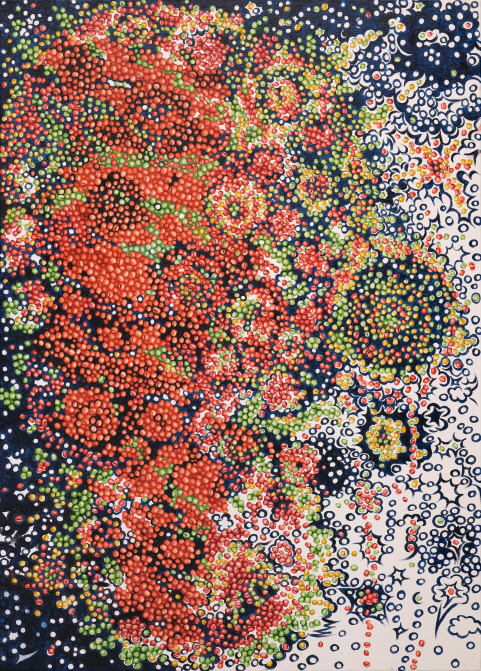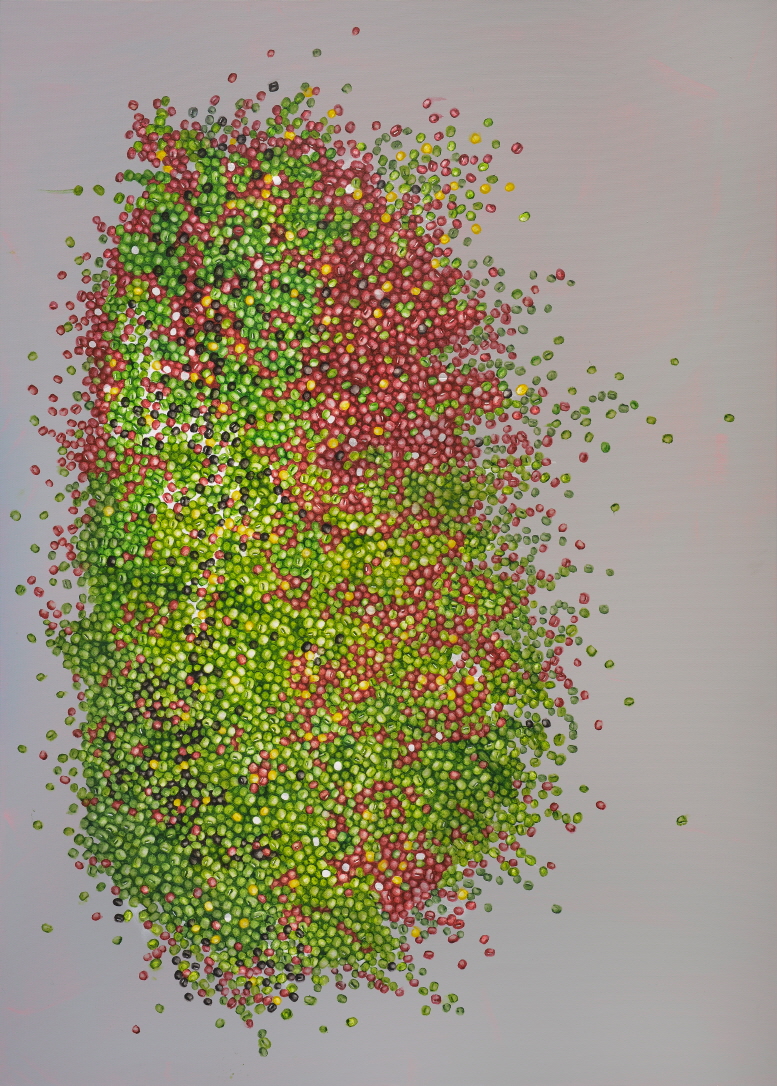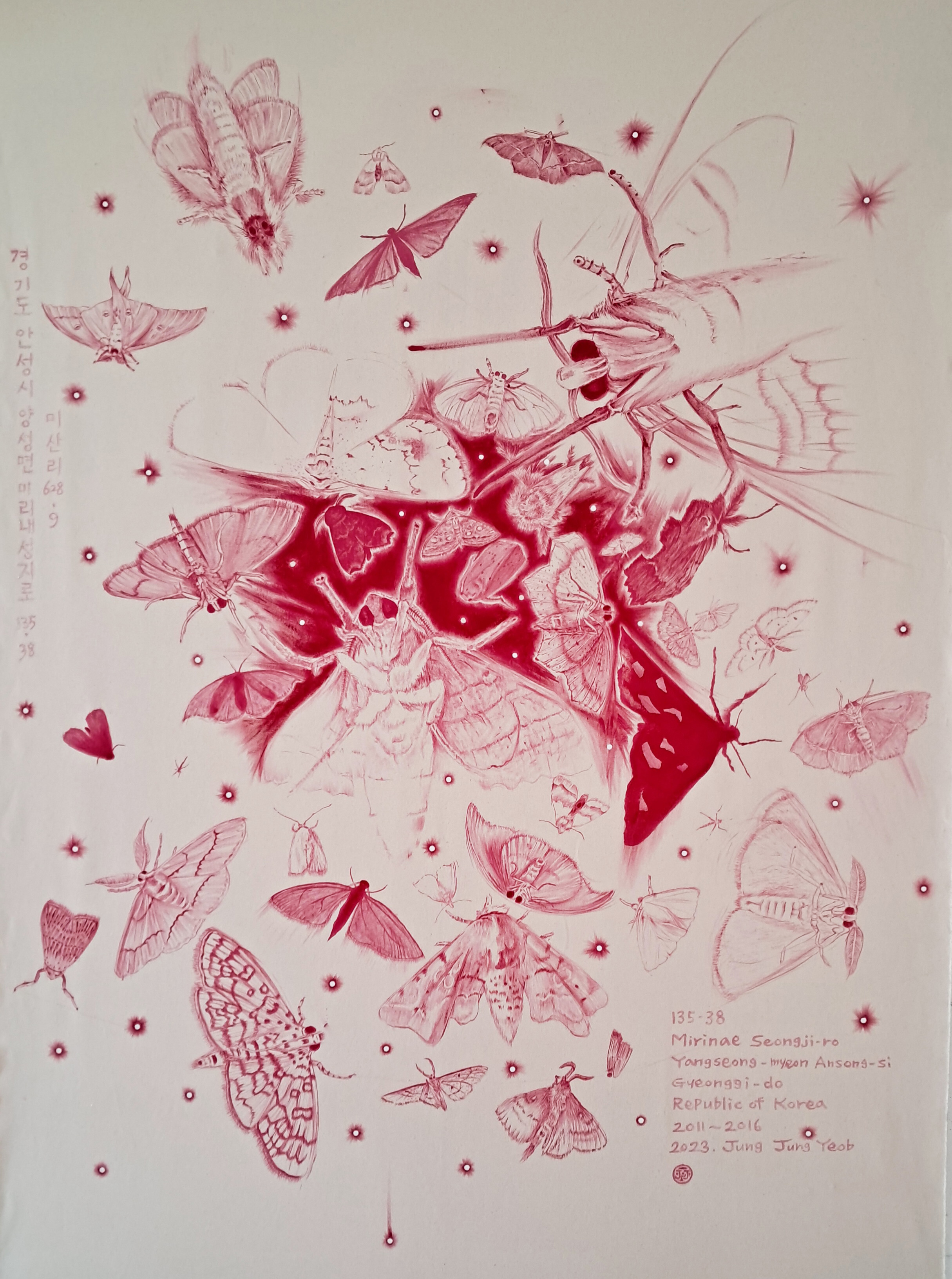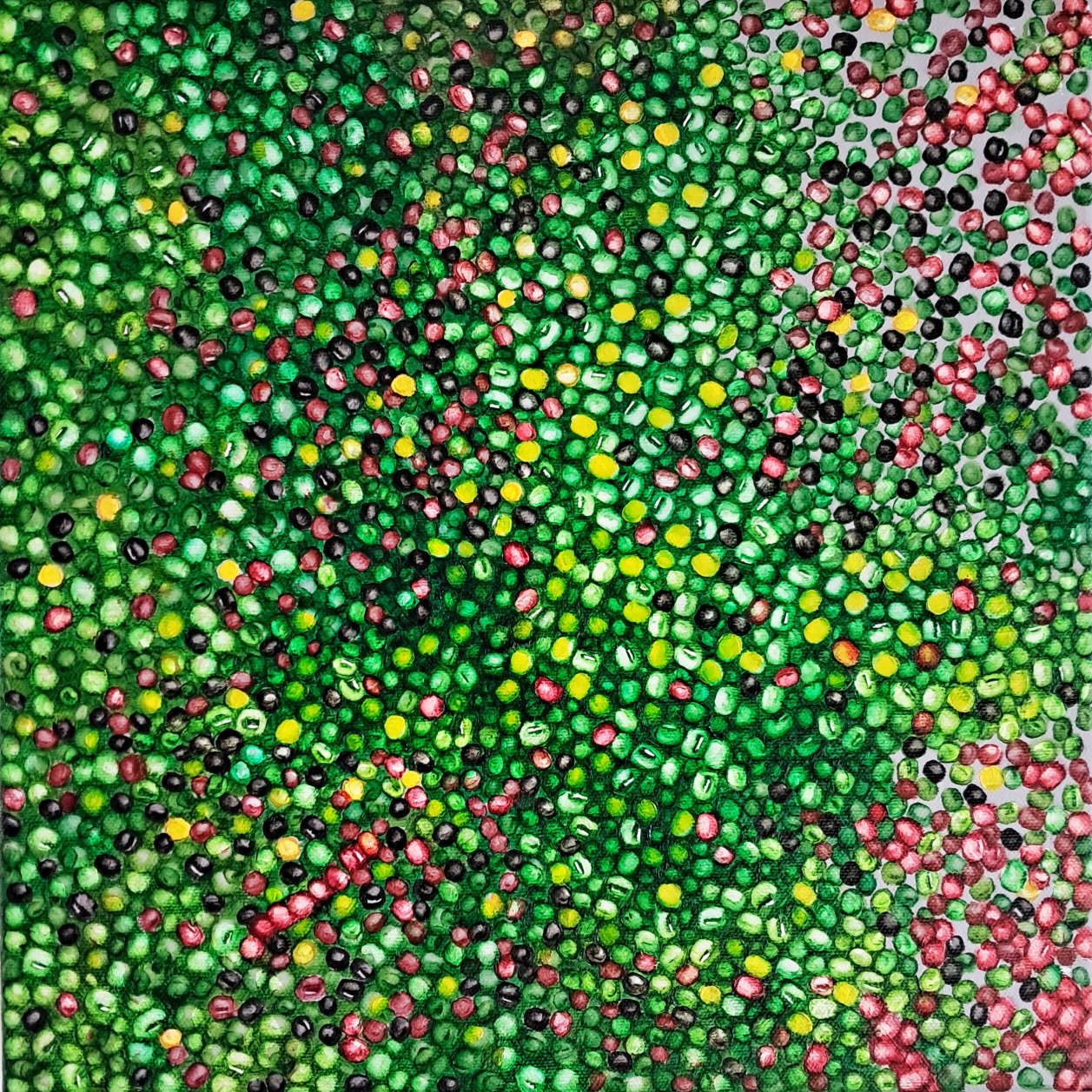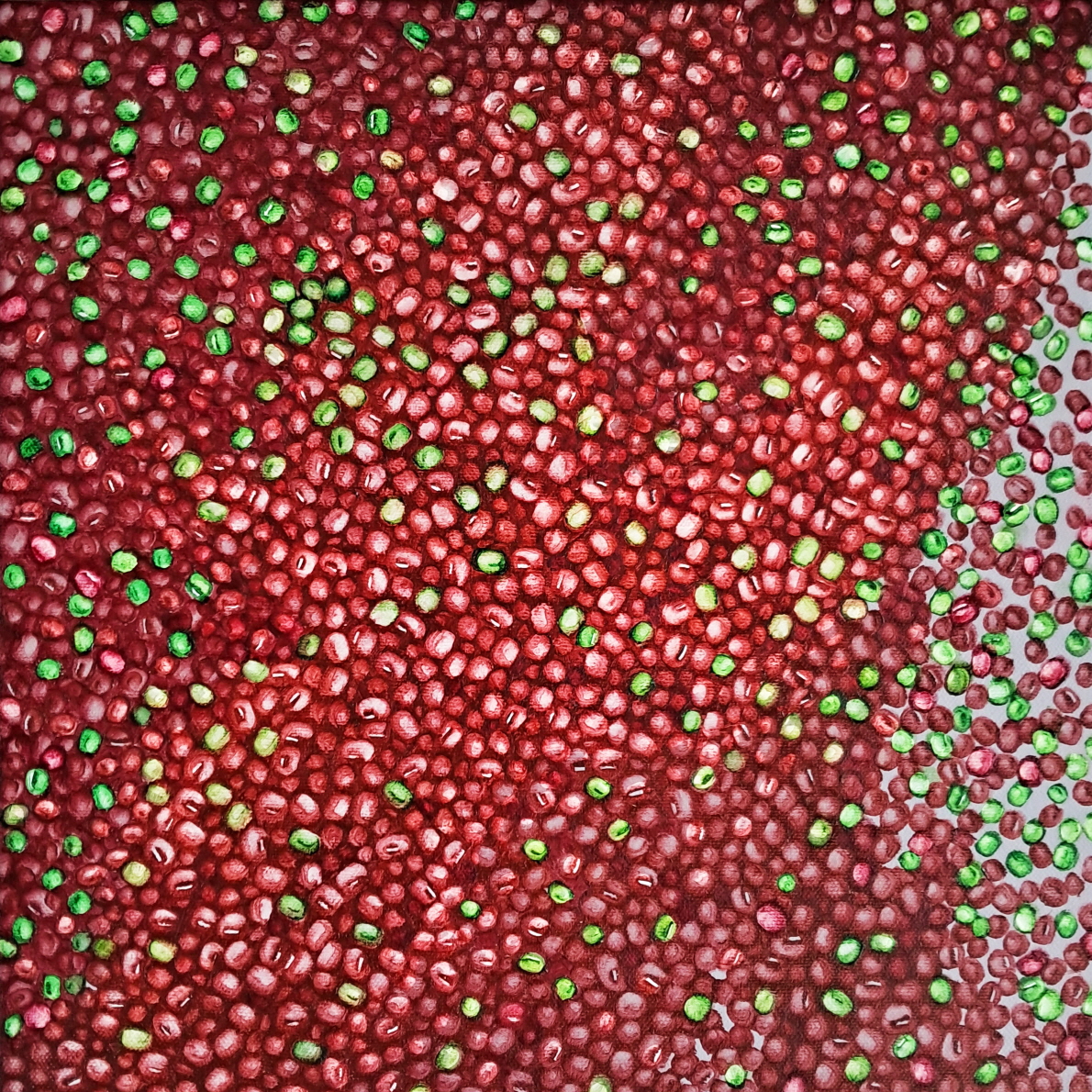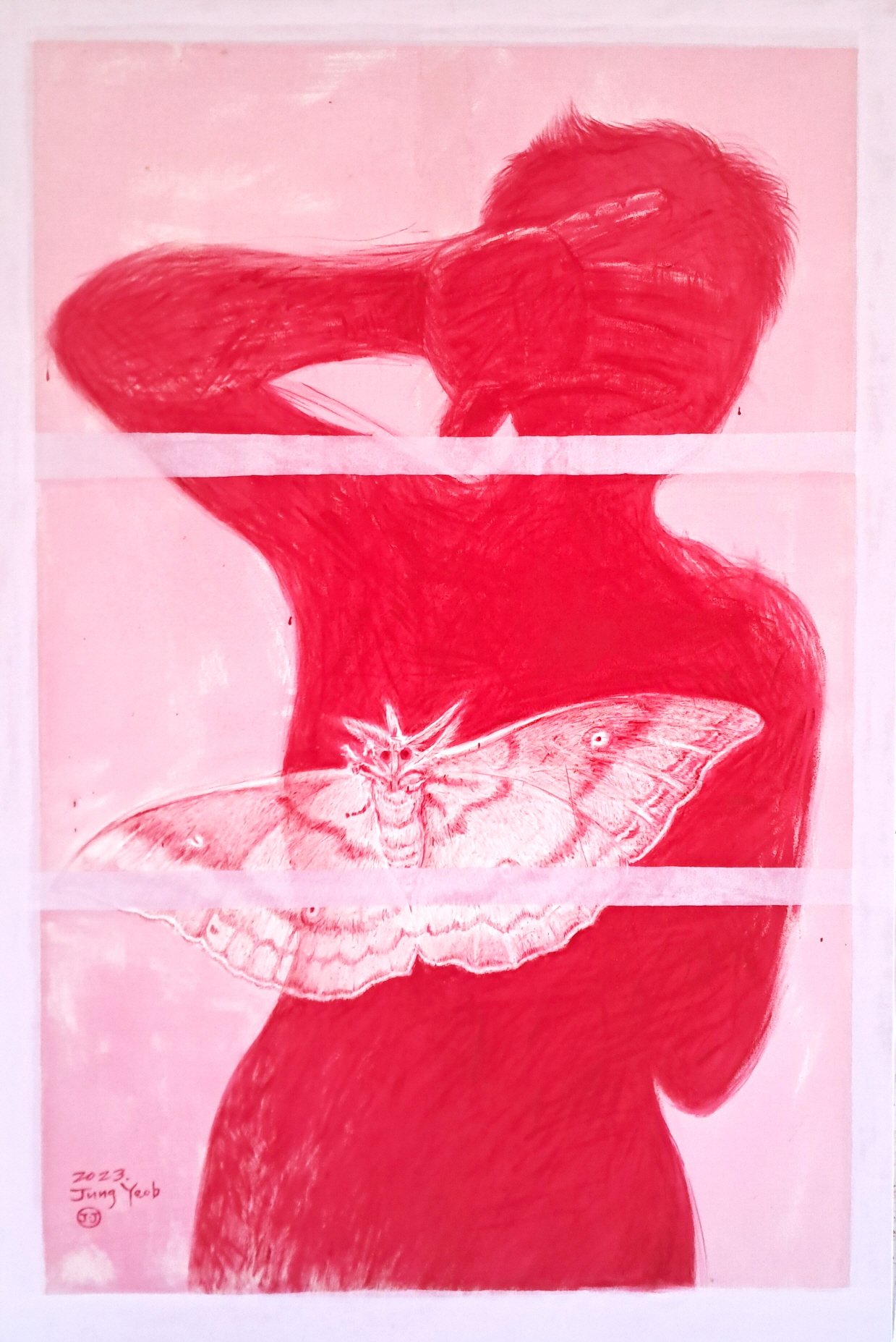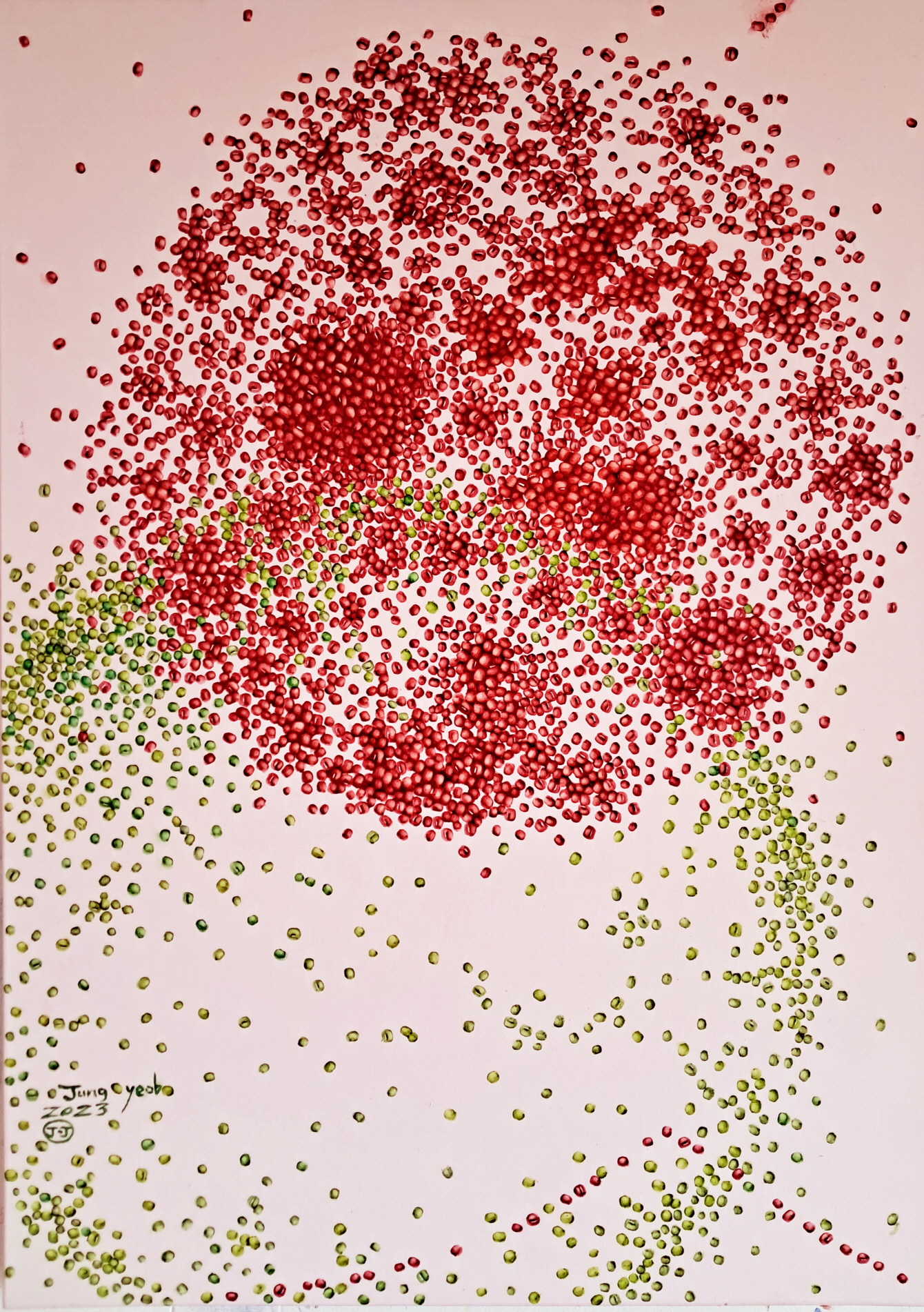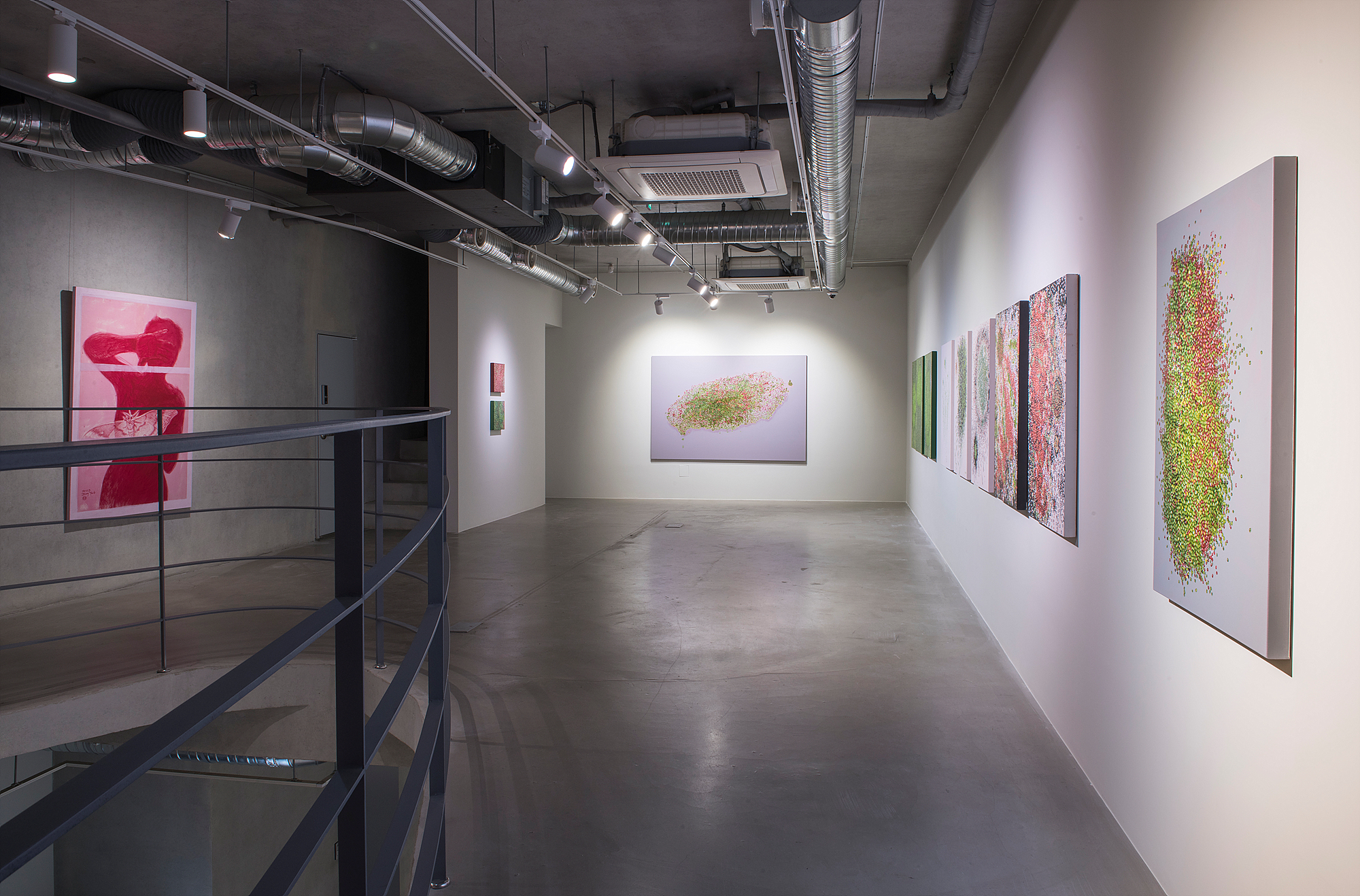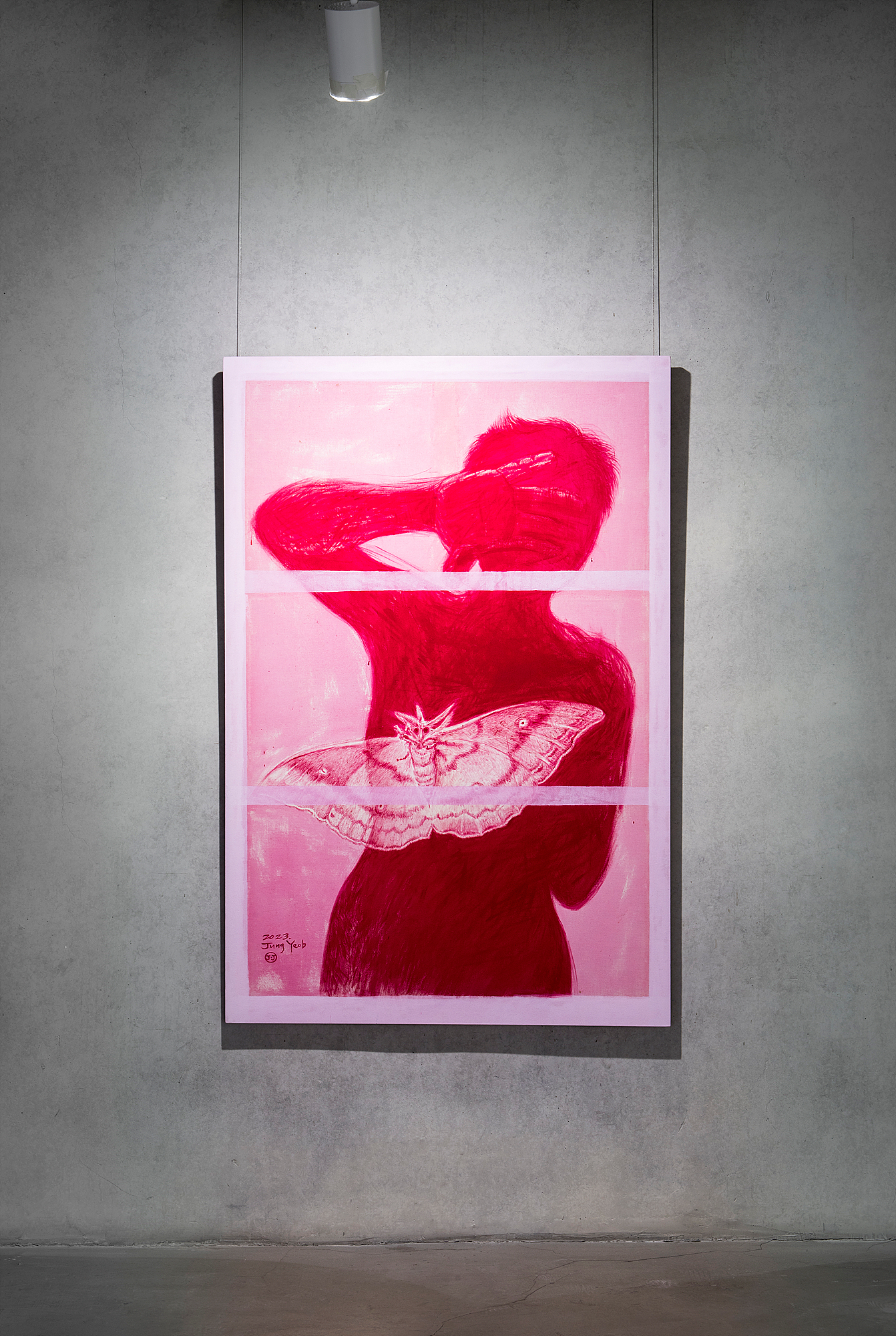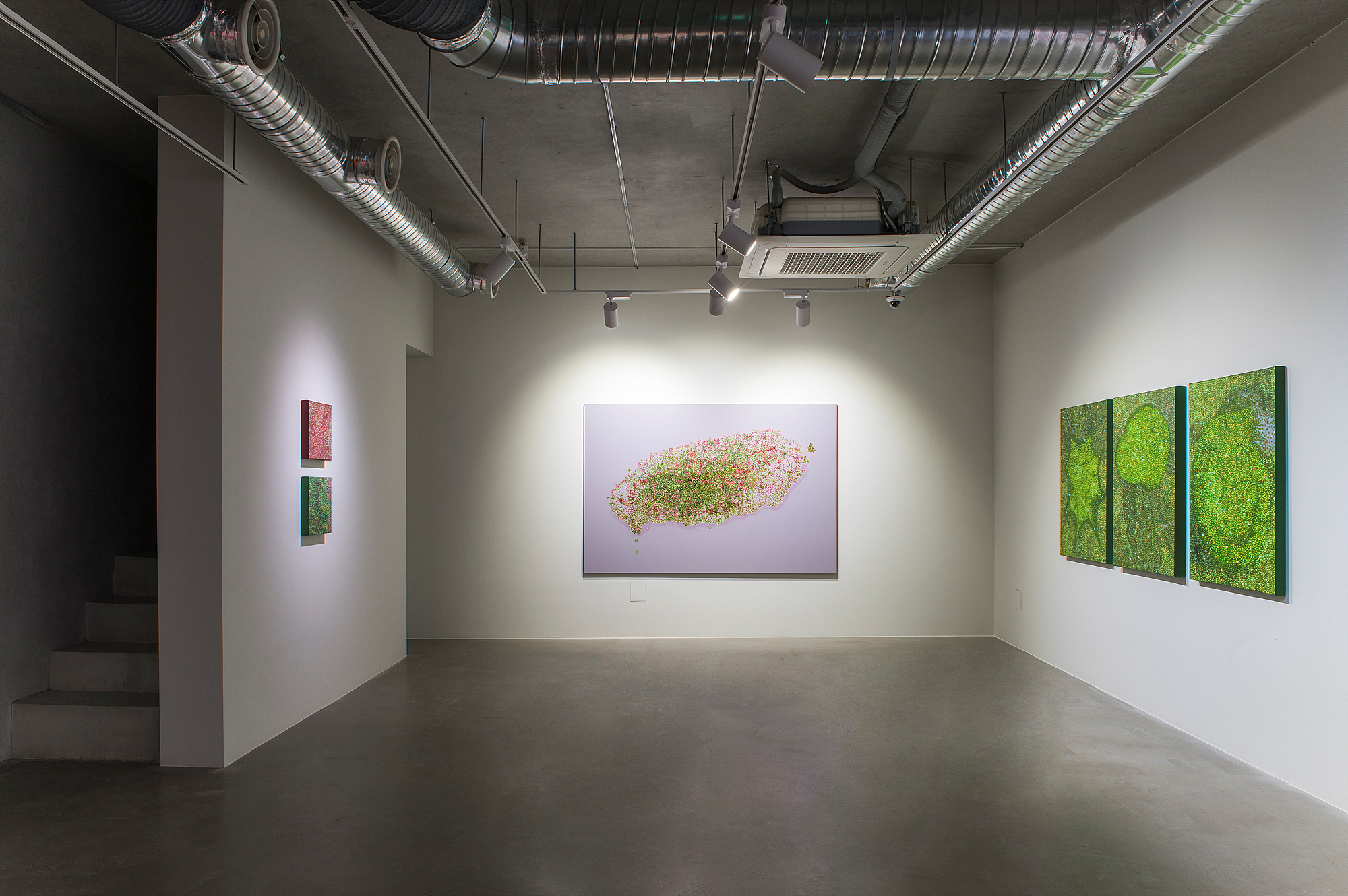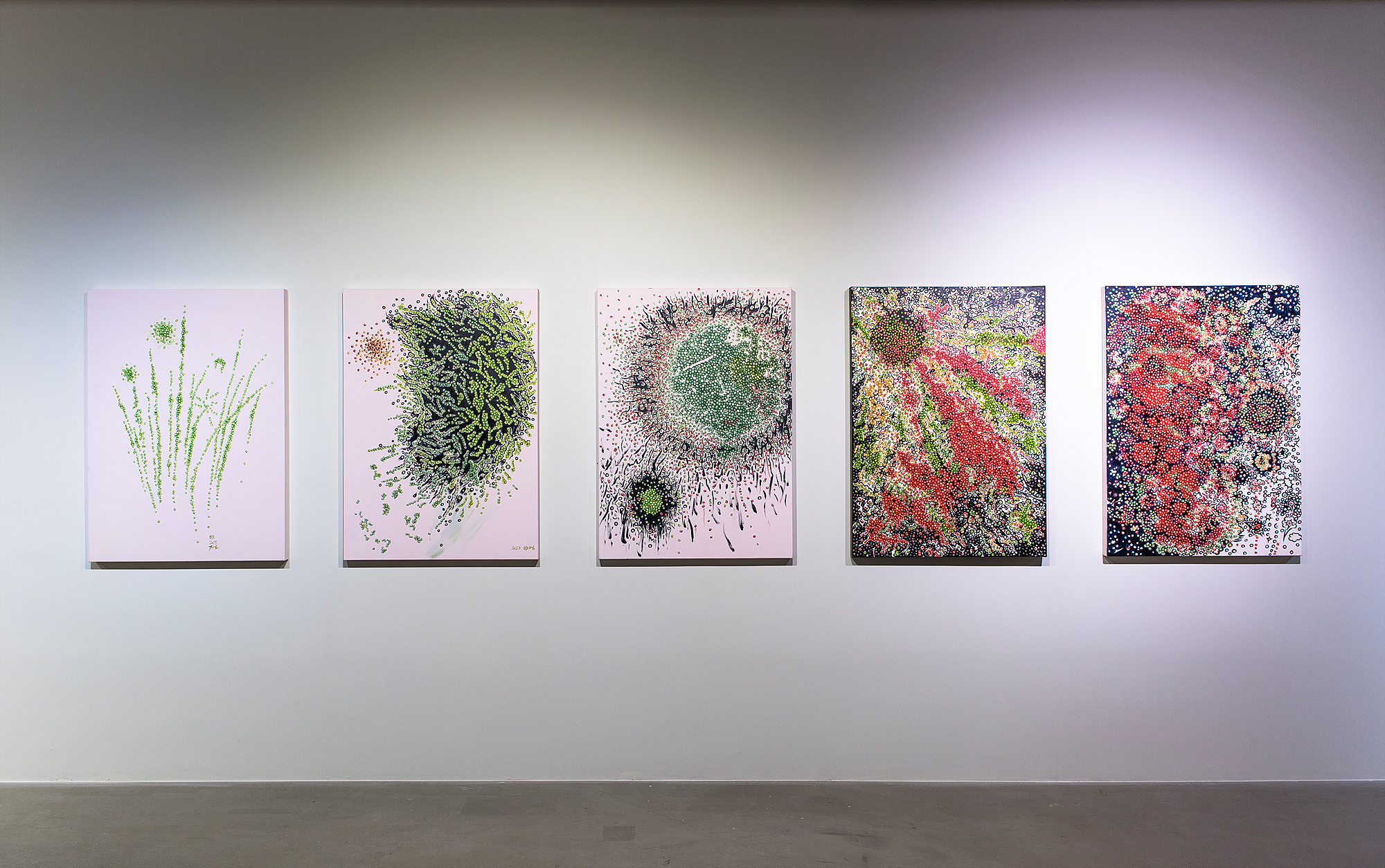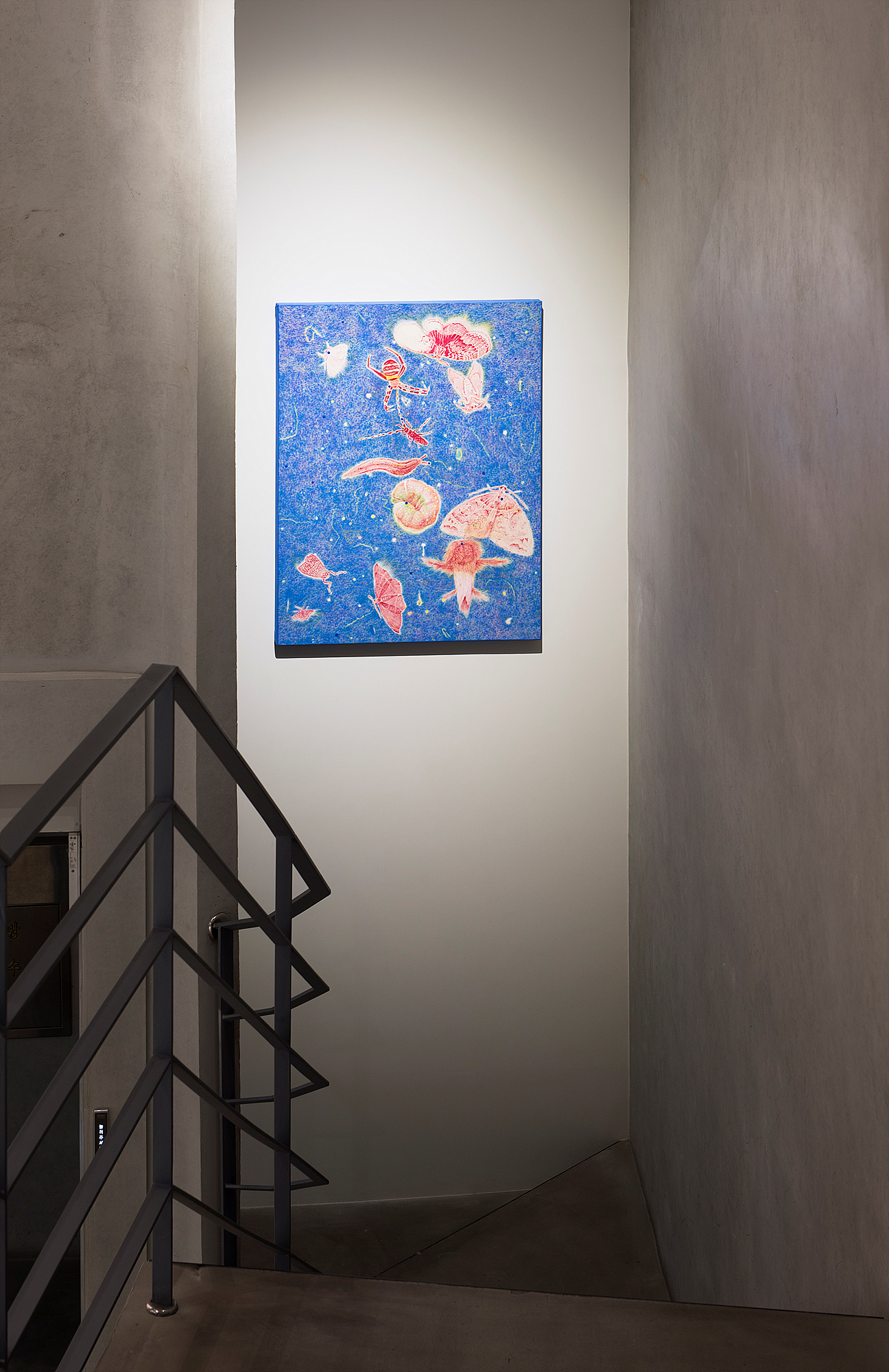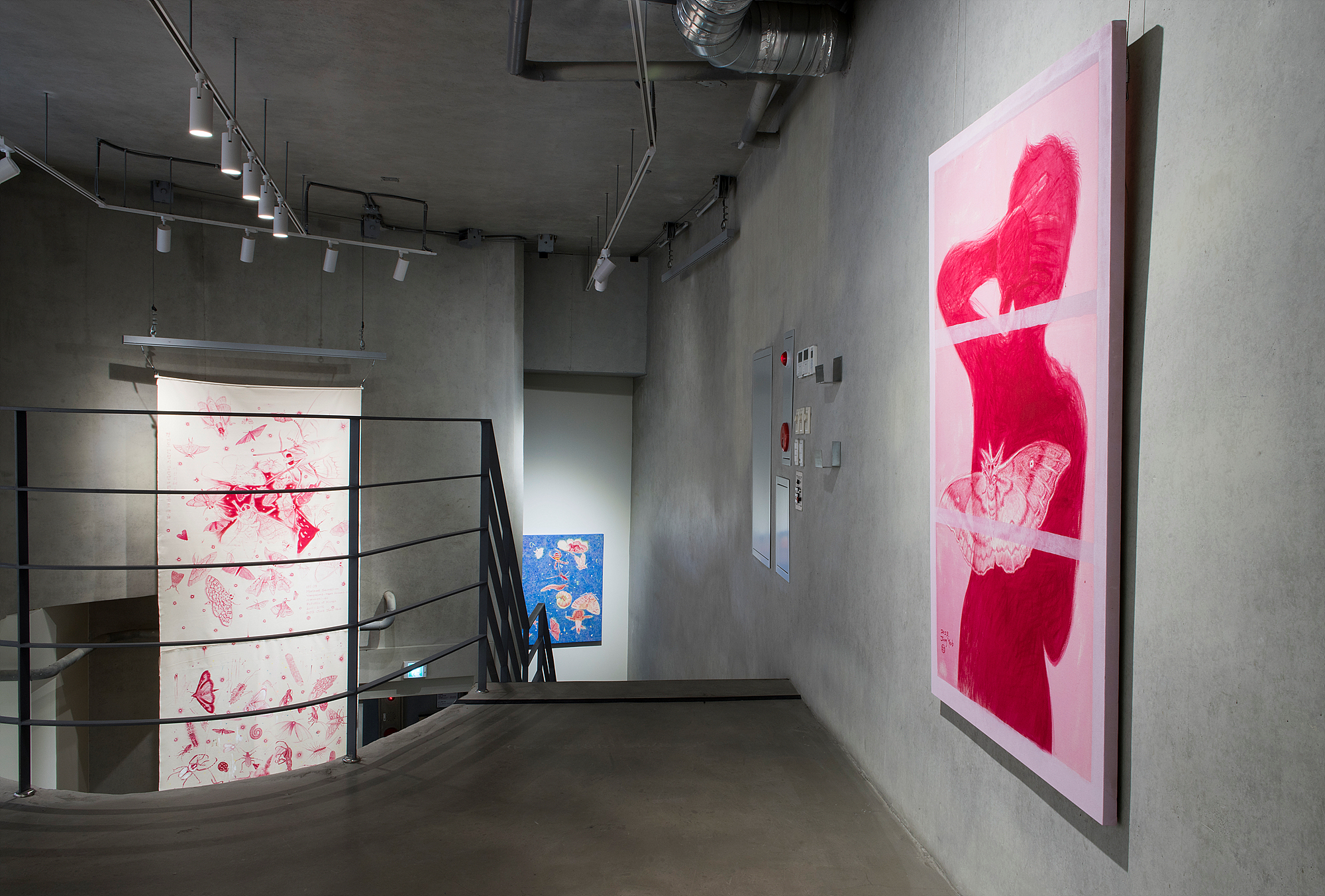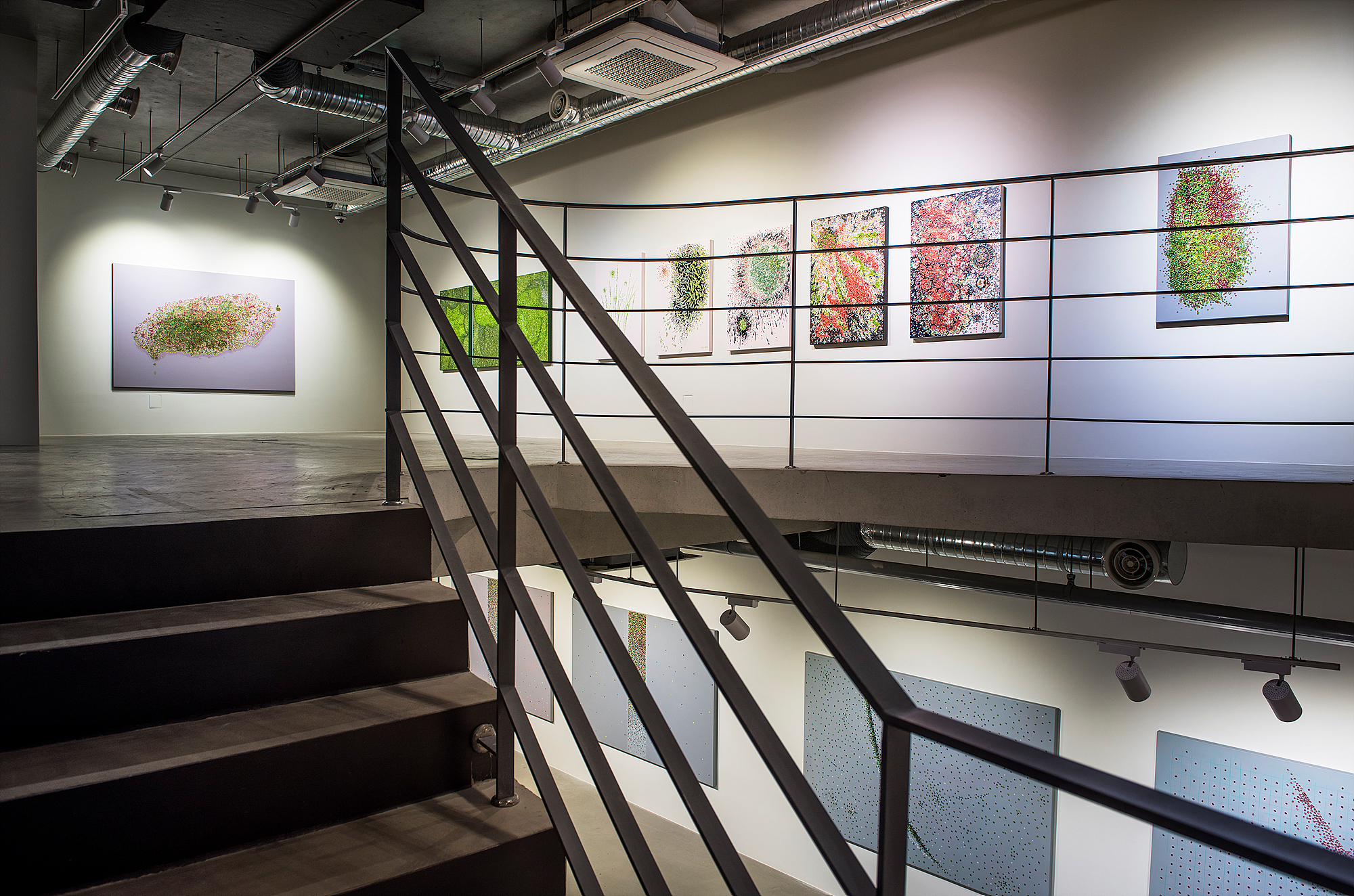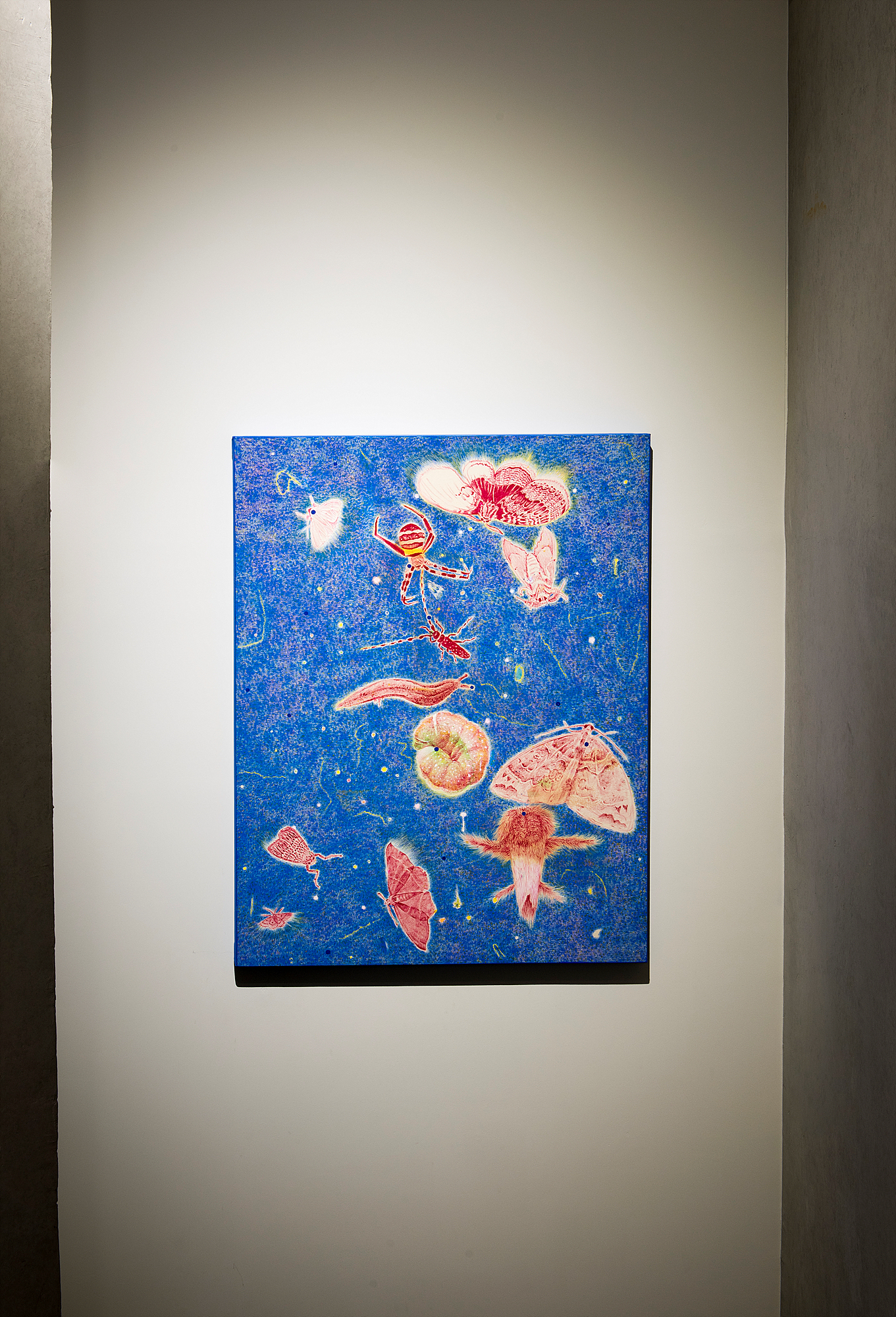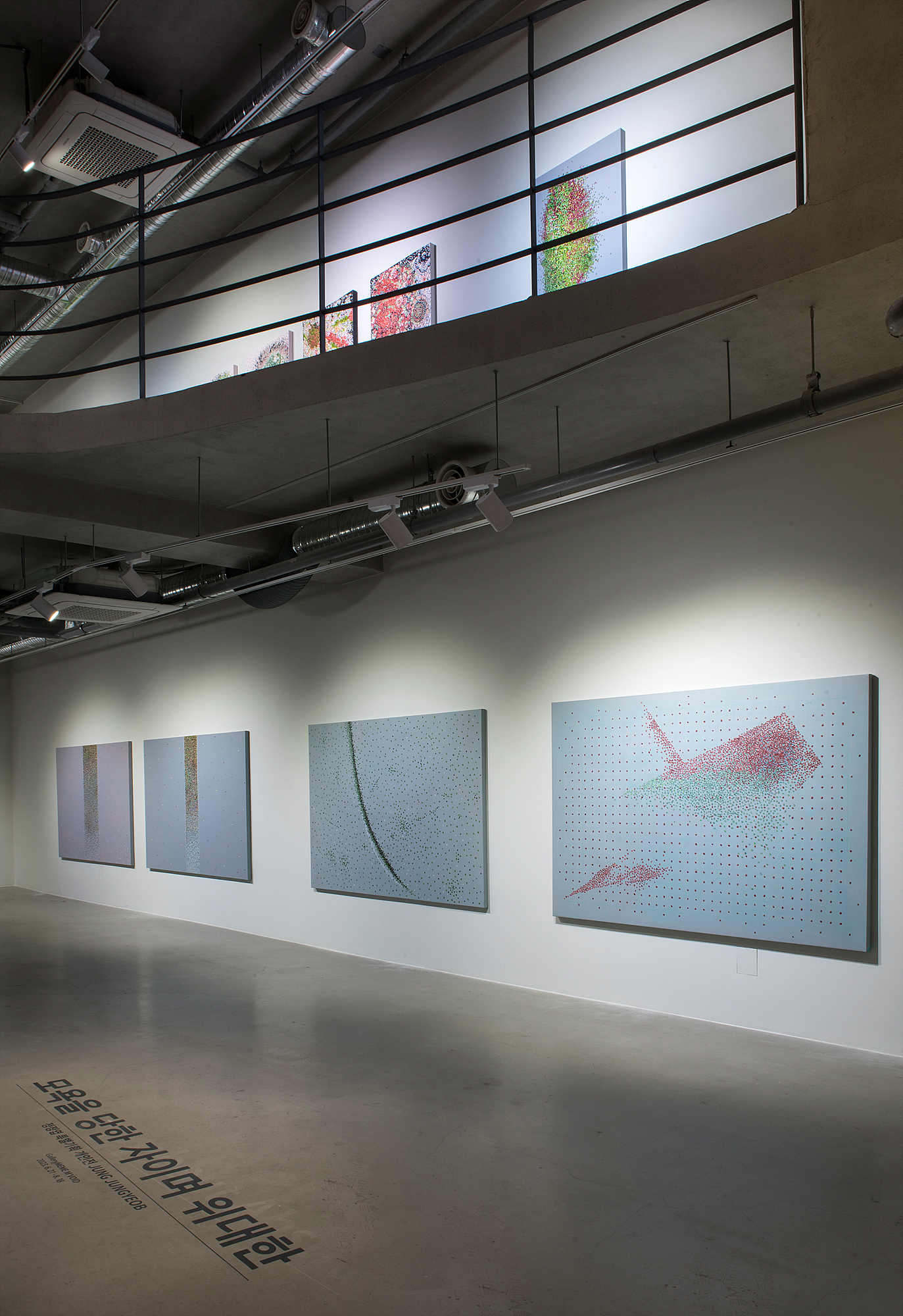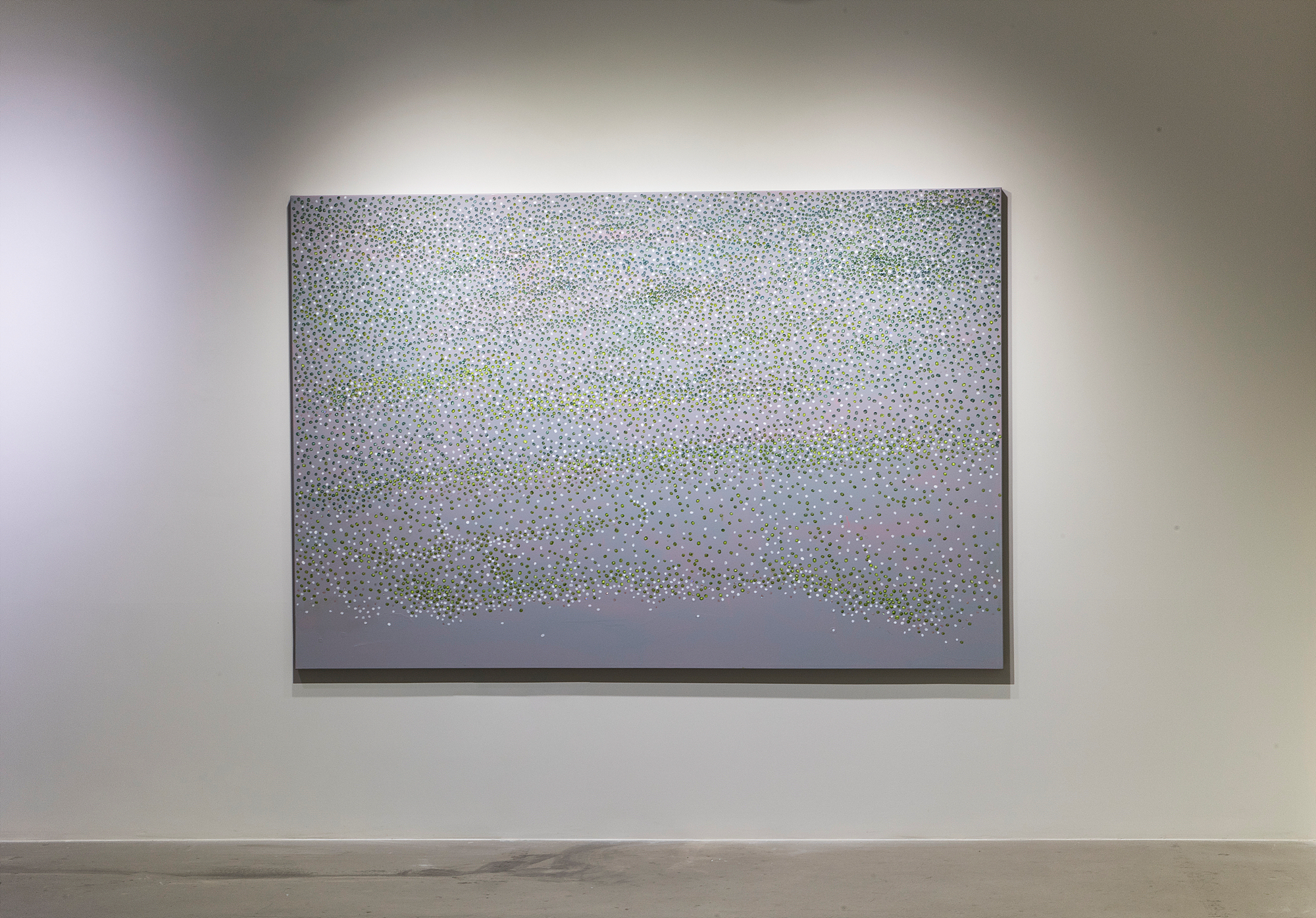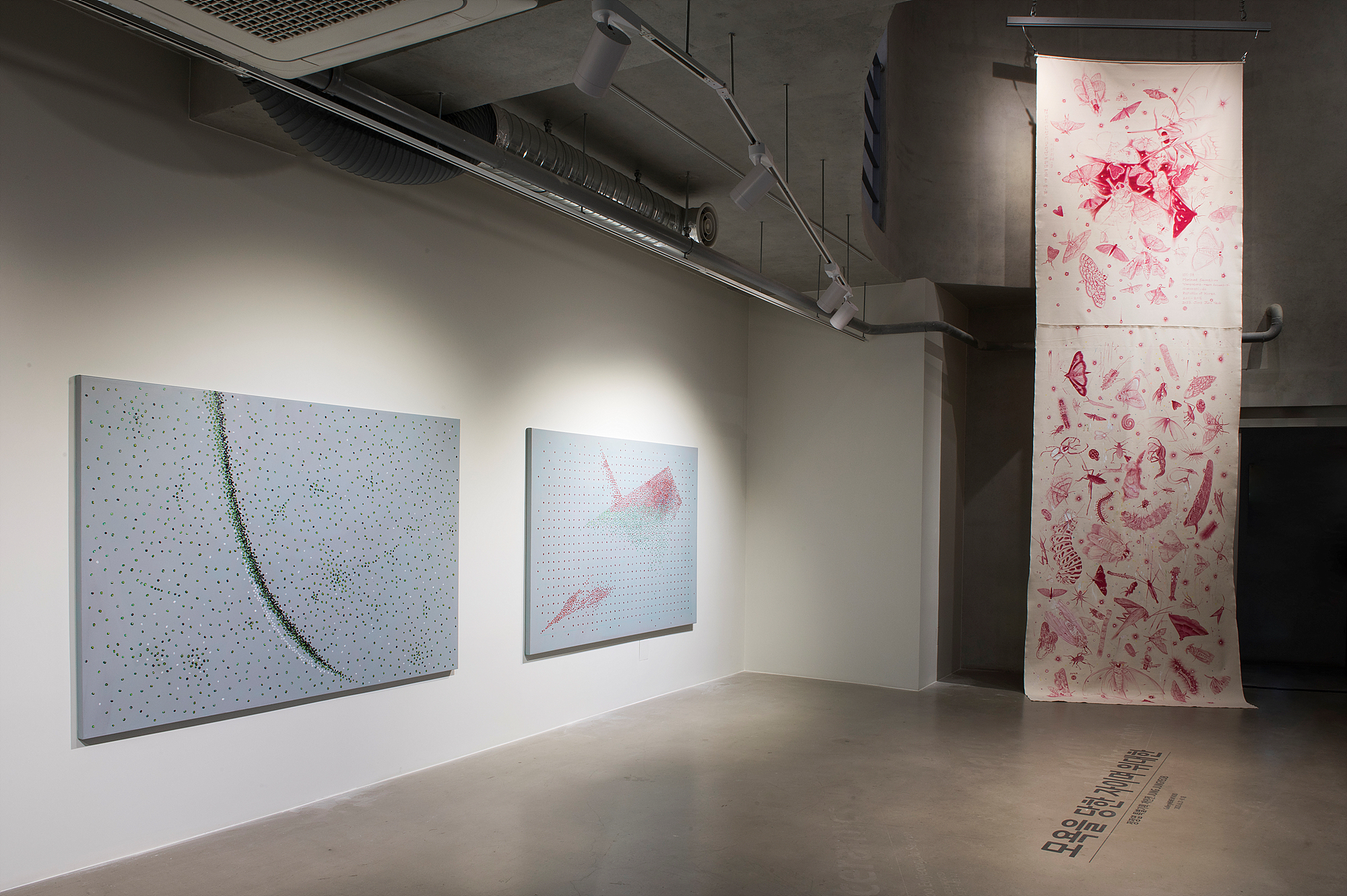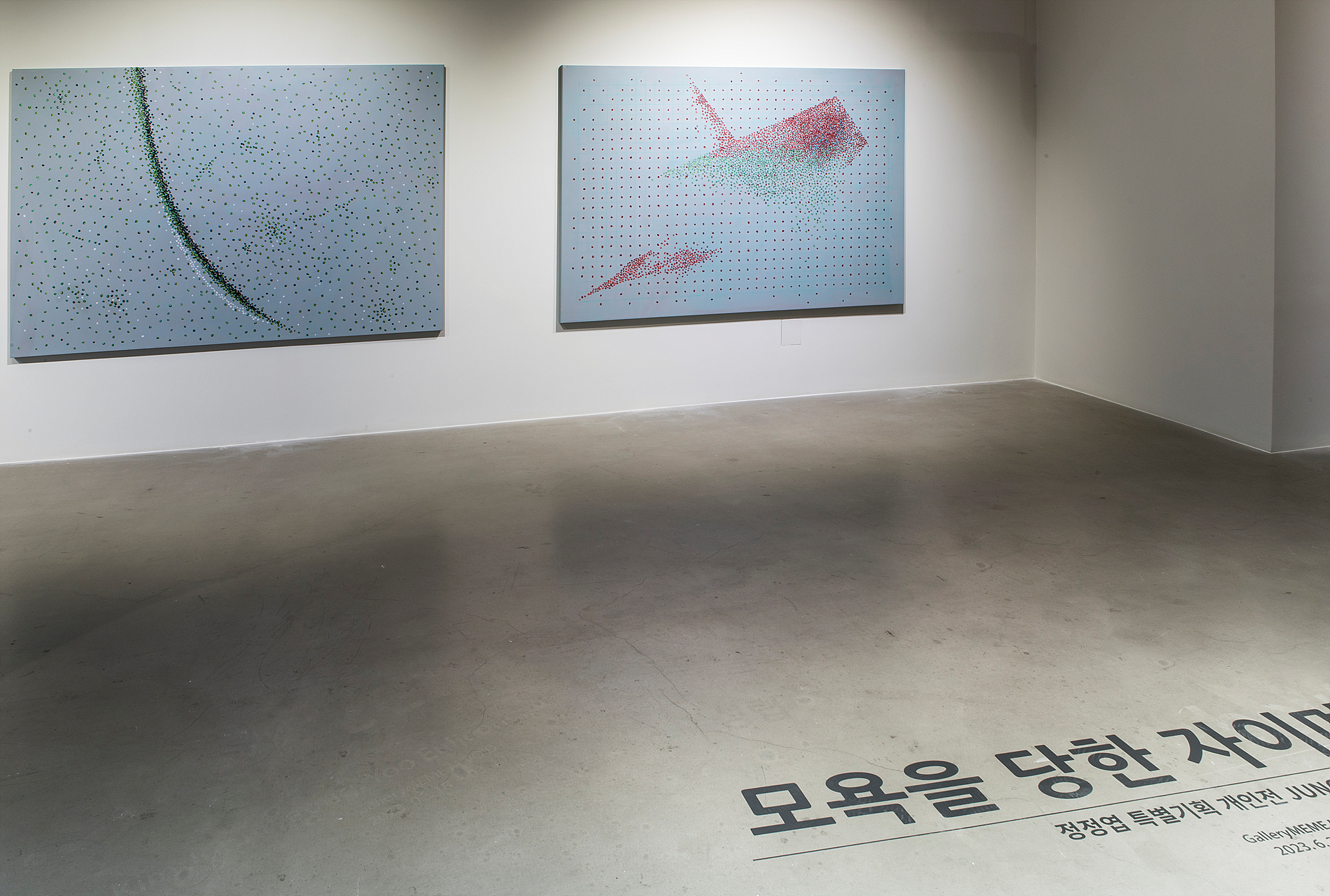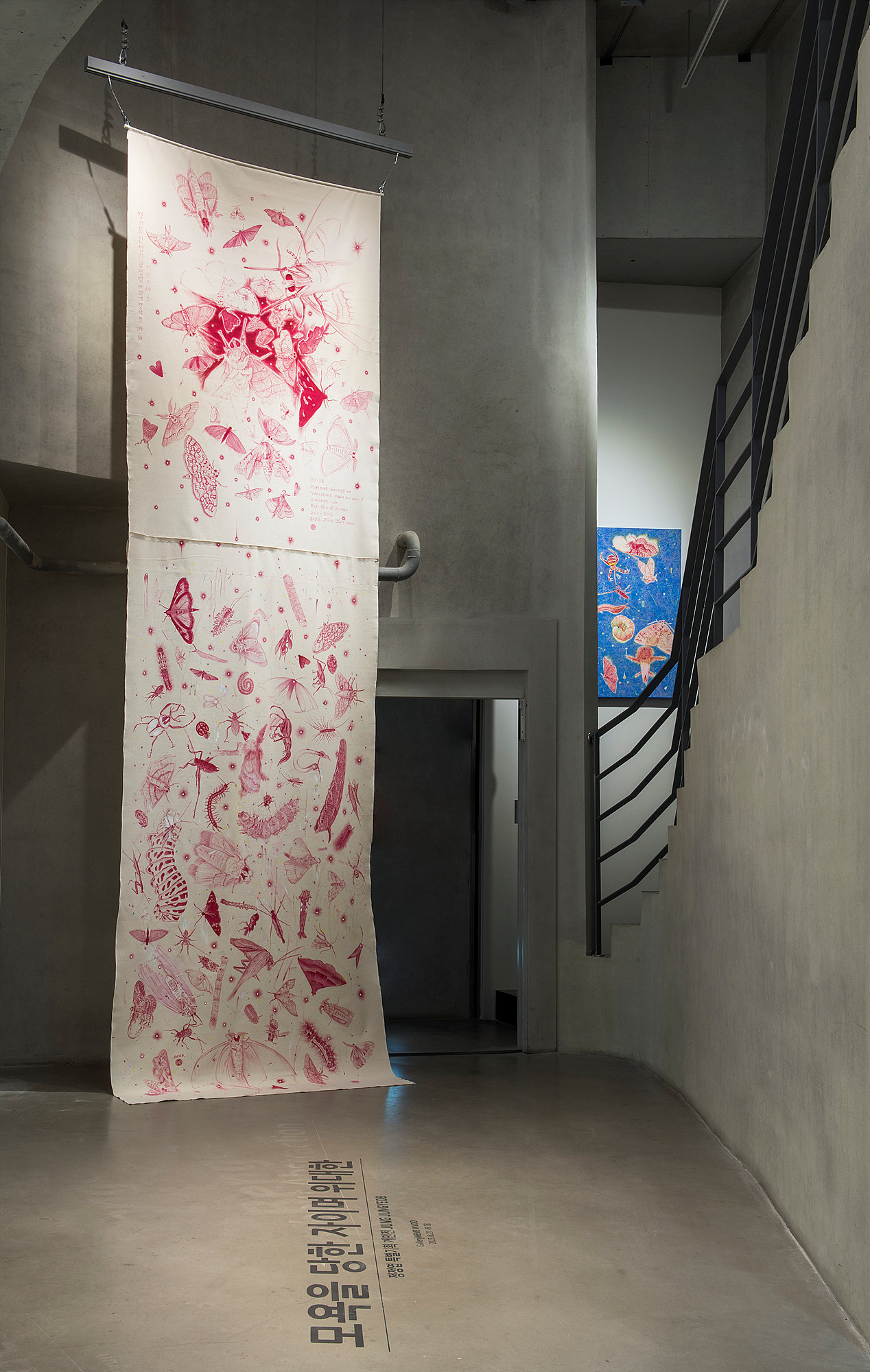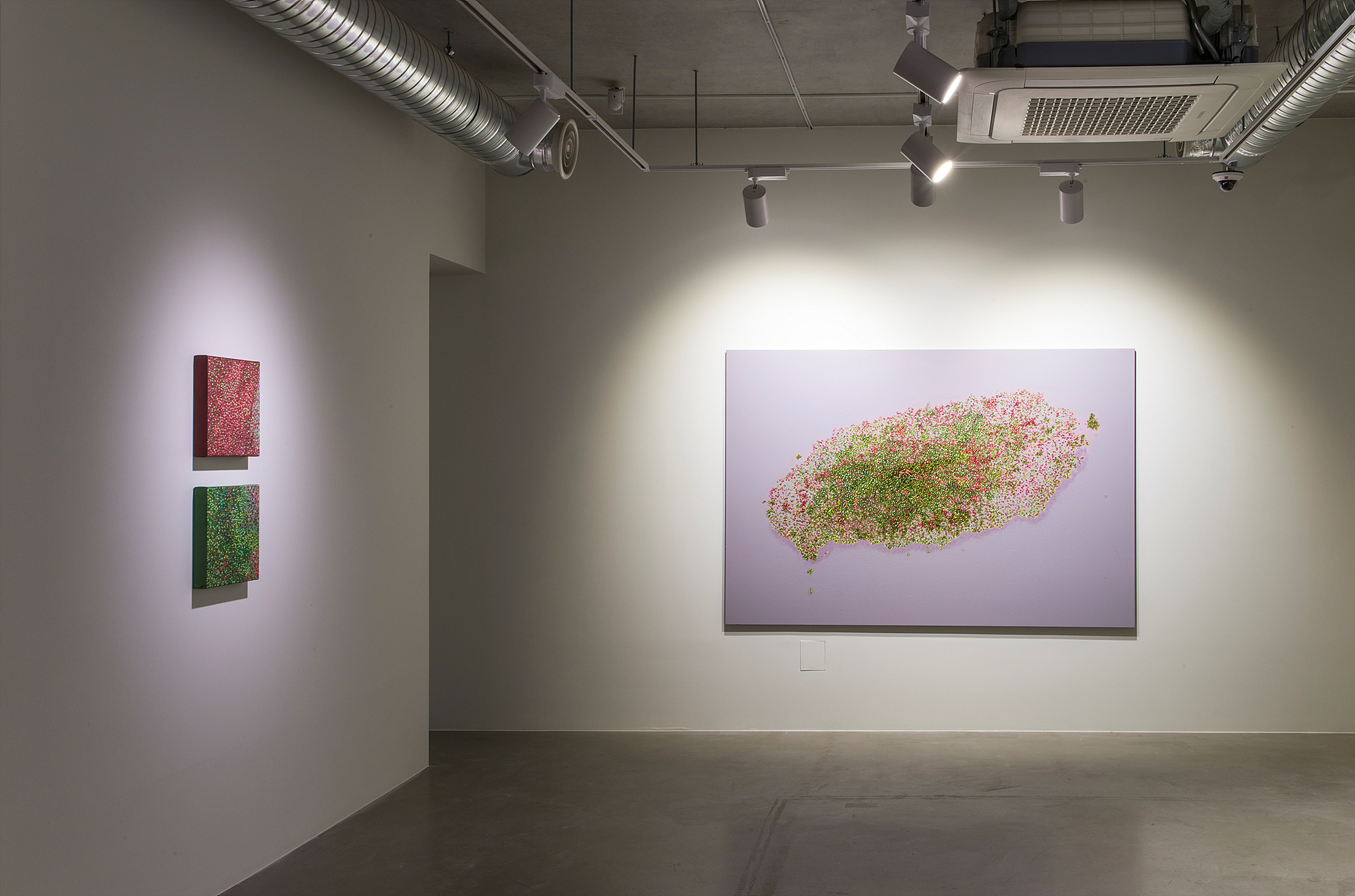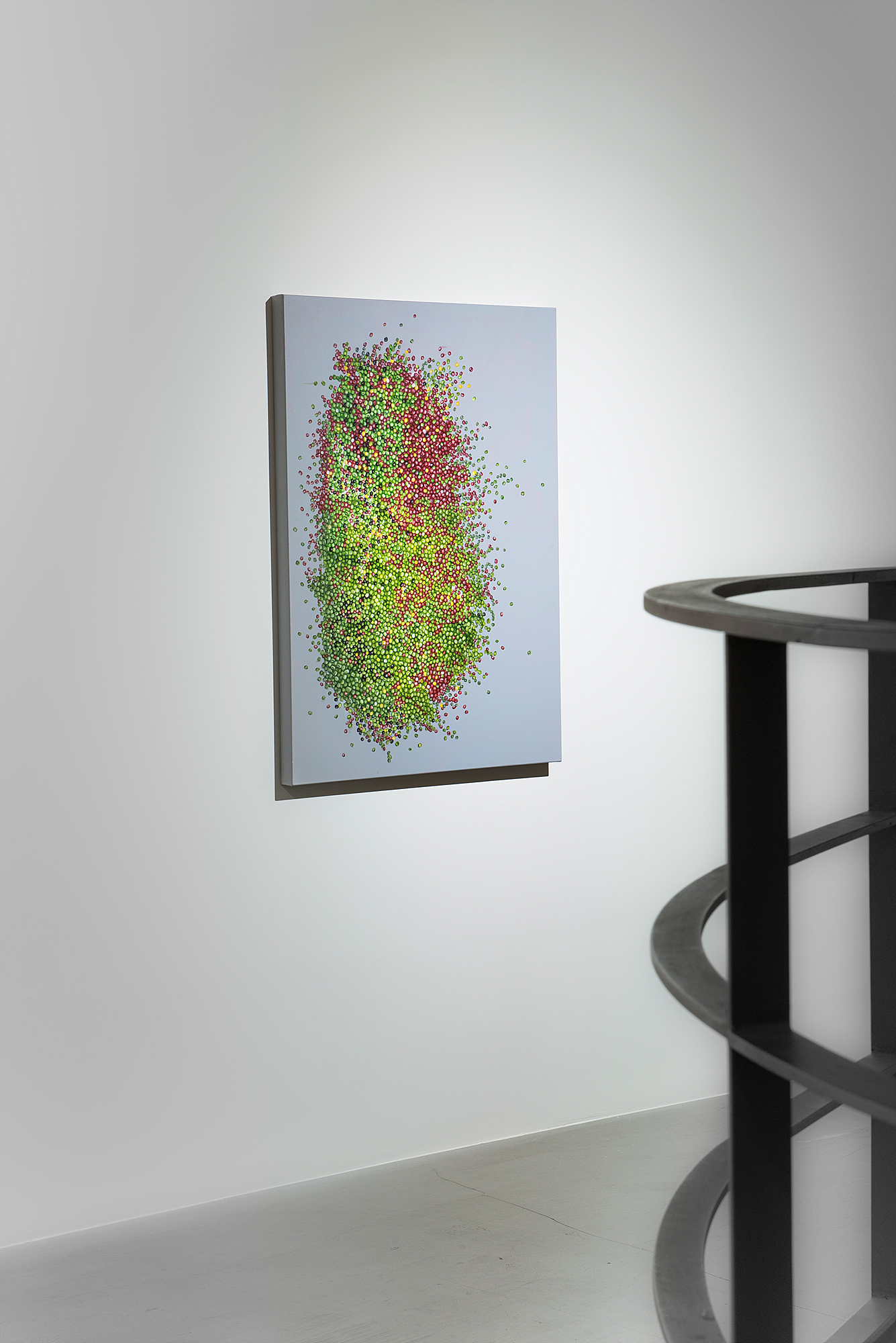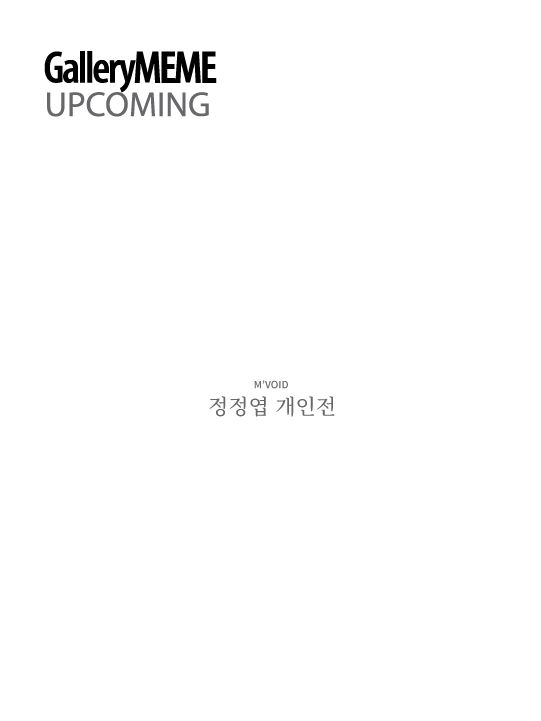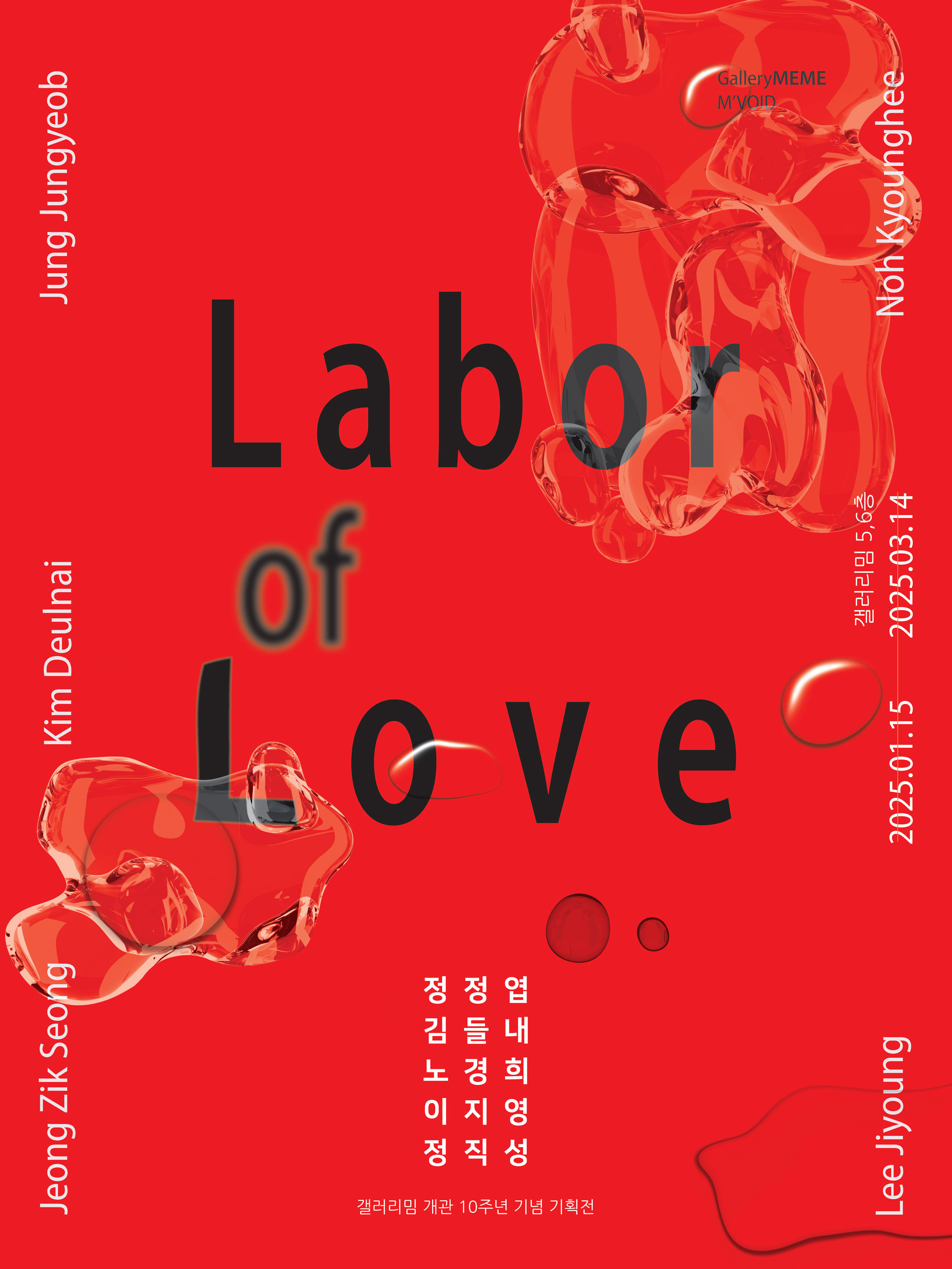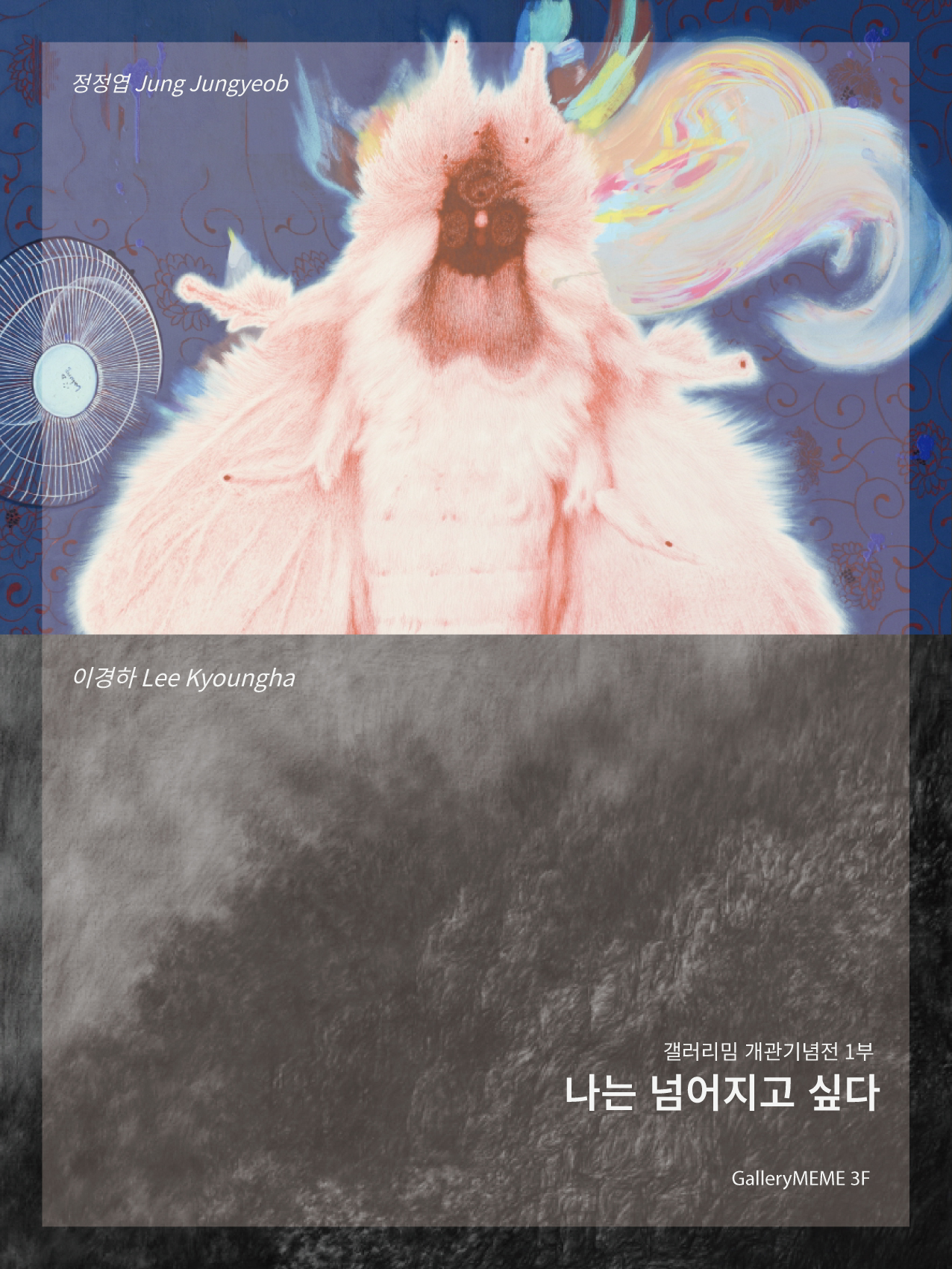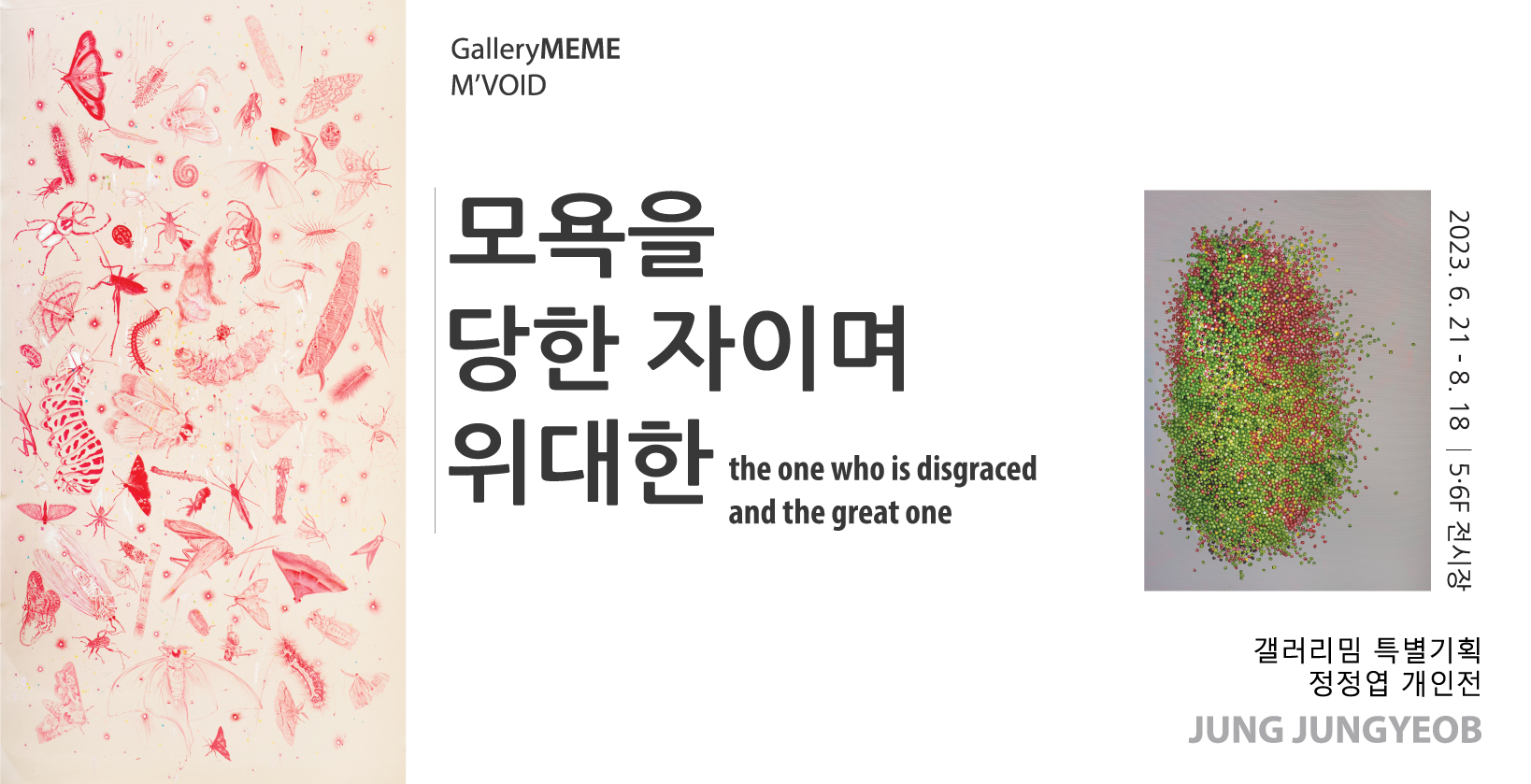
모욕을 당한 자이며 위대한
Jung Jungyeob
M’VOID is a program that plans and presents exhibitions of leading artists at home and abroad who question contemporary aesthetic values while strengthening their works with insights.
ABOUT
전시 서문
정정엽, ‘모욕을 당한 자이며 위대한’
“너는 난(蘭)을 쳐라, 나는 파(蔥총)를 친다!”(이하 ‘난ㆍ파’)[1]
정정엽 작가를 한 문장으로 소개하라면, 그의 호기로운 상기 언급이 제격이다. 물론 그의 CV는 길고 묵직하다. 약술하면, 이화여대 졸업 후, 1985년 <두렁>에 가입하면서 미술 밖에서 미술에 질문을 던지며 사회적 참여를 실천하고, 여성미술연구회를 통해 여성의 보이지 않는 노동에 관심을 지속해 왔다. 수십회의 개인전과 단체전에 초대받고, 2018년 제4회 고암미술상과 2020년 양성평등문화인상, 2022년 이중섭미술상을 수상했다.
서구에서는 일반적으로 남성적인 사상을 기반으로 문화예술이 발전했다. 동양에서는 그나마 ‘음양陰陽’의 조화를 중시 여겼음에도 불구하고, 역시 마찬가지였다. 여기서 이원론을 다시 끄집어 내려는 것이 아니다. 이기적인 생물학적 유전자(GENE)는 어쩔 수 없더라도, 문화적 진화의 유전자인 밈(MEME)은 수정될 수 있기에, 편견의 눈꺼풀을 벗겨 내려는 것이다. 공교롭게도, 올 여름, 정정엽 작가의 혁명적인 ‘씨’(seed)가 파종 될 밭이 갤러리 밈(MEME)이다. ‘모욕을 당한 자이며 위대한’展(2023.6.21~8.18)에서는 확장된 관점, 타자의 시각을 요청한다. ‘난’(사군자, 산수화; 陽)을 치기 위한 ‘준법’이 있듯이, 작가는 ‘파’(채소; 陰)를 치기 위한 서양화적 준법을 발견했다. ‘난ㆍ파’, 이 한 문장은 그의 예술미학, 과정, 동양화 미술사뿐만 아니라 현대 서양 미술사까지 총체적으로 그 상황을 반영한다.
콩: 점, 생명의 씨앗
정정엽의 작업은 다양하고 다른 주제의 전개에도 불구하고, 일관된 미학적 줄기가 체계적으로 발전되고 있다. 초기 작업부터 그는 전통미술에 근거를 두고 이를 사회적, 현대적, 생태학적으로 업데이트하고 있다. 그의 초기 목판화에서도, 민중미술 판화의 일반적인 기법으로 여겨질 수 있는데, 판화 기법을 보면 모티브를 감싸는 선이 민화의 마감선과 같다. 그래서 때로는 재현된 형태에서 그 느낌을 받을 수 있다.
<마을벌레>, 낯설고 친숙한
정정엽 작가는 생 광목천에 사생하듯, 안성 미산리에서 만난 80여 마리의 벌레들을 재현했다. 그의 표현대로, “낯설고 친숙하다”. 처음에는 “뒤로 물러서게 만드는” 징그럽고 겁나는 벌레에게, 2011년부터 한 발자국씩 가까이 다가간다. 그러면서, 그는 “벌레마다 기기묘묘하며 대체불가한 독특한 모양과 움직임”이 있음을 인지하고, 그 신비로움을 화폭에 담는다. 그가 얼마나 가까이 벌레에게 다가갔는지는 그의 그림에서 그대로 드러난다. 그는 벌레 안에서 “지상의 모든 형상”을 보기도 한다. 우리 인식의 편견의 껍질을 벗은 벌레의 모습은, 저주받은 미물이 아니라 신기하고 아름다우며 품위도 있는 모습으로 화면을 가득 채운다. 벌레들 뒤로 푸른 밤하늘의 밝은 별들이 반짝인다. 남극 근처에 있는 ’파리 자리 Musca’는 1930년 '국제천문연맹(IAU)이 정한 88개 별자리(constellation) 중 유일한 곤충자리이다. 관람객들은 작품 속에서 각각의 벌레에 그들의 별자리를 만들어 줄 수도 있다.
작가는 전시 제목에 ‘모욕을 당한 자이며 위대한’이라는 양의적인 성격을 수여한 것일까? 시대의 요청에 따라, 작가의 ‘타자’ 역시 바뀌는데, ‘민중’에서 ‘여성’(타자, 陰의 ‘준법’ 포함)으로, 그리고 이제 가장 시급한 ‘벌레’(기후, 생태계의 타자)로 관점이 이동된다. 이들은 모두 위대하게 태어났으나, 모욕과 망신을 당해 왔다. 그리고 다시 시대적 관점의 변화 등으로 조금씩 복귀가 되나, 그들 스스로 위대함과 존엄성을 자각하지 못하고 있다. 그래서 작가는 붓을 통해 이를 재현한다. 위대한 생명의 담지자들, 망신을 당해 왔으나, 다시 그 존엄성과 초월성이 드러나기를 바라며, 작가는 그동안 모욕과 망신을 당해온 모든 타자들의 고귀함과 생명의 숭고함을 드러내며, 우리의 편견을 한 꺼풀 벗겨낸다. 지면의 한계가 없다면, 필자는 현재 활동하고 있는 국제적인 ‘벌레’와 ‘콩류’ 작가들을 비교하고 싶었다. 더욱이 기후나 생태 재난을 목전에 두었기에 쉽게 찾으리라고 여겼다. 그러나 생각보다 힘들었다. 그만큼 우리의 시각이 생각보다 넓지 않다는 것을 깨닫는 기회가 되었다. 그의 작업은 WEB3.0 시대에 신체성을 상기시키고, 기후재난 시대에 벌레에 대한 관점을 전환시키고 있다.
심은록 (SimEunlog MetaLab.연구원, 미술비평가)
[1] 이 글에서 출처 없는 인용문은 정정엽 작가와 심은록의 인터뷰(2022.12.3)와 그의 “작업일지”(2023.4.25)에서 인용 됐다.
전시 제목에 대한 소개
*1945년 이집트에서 발견된 ‘나지함마디 문서’(2~3세기에쓰여진 것으로 여신의 신성에 대한 텍스트를 모은 것)에 기록된 내용 중 ‘I am the one who is disgraced and the great one’에서 가져옴.( ‘The Goddess’, 샤루크 후사인)
Jung Jungyeob, “The One Who Is Disgraced and the Great One”
“You draw the orchid, I draw the green onion!” (Hereinafter referred to as “Orchidㆍgreen onion”)[1]
If we have to introduce the artist Jung Jungyeob in one sentence, her pompous comment above would be perfect. Of course, her CV is long and copious. In brief, after graduating from Ewha Womans University, she joined the Dureong Group in 1985 and practiced social participation by raising questions about art while staying outside the art world. And as a member of the Women's Art Research Association, she has shown a continuing interest in women's invisible labor. She has been invited to dozens of solo and group exhibitions, and won the 4th Goam Art Award in 2018, the Gender Equality Culture Award in 2020, and the Lee Jung Seob Art Award in 2022.
In the West, culture and art in general developed based on masculine ideas. In the East, the harmony of 'yin and yang' was emphasized, but in the end it was not much different. Here I am not trying to bring in dualism again. I want to remove the veil of prejudice, because even if the selfish biological gene (GENE) is unavoidable, the MEME, which is the gene of cultural evolution, can be modified. Coincidentally, this summer, Gallery MEME became the field for Jung Jungyeob's revolutionary 'seed' to be sown. The exhibition “The One Who Is Disgraced and the Great One” (June 21-August 18, 2023) calls for an expanded perspective and standpoint of others. Just as there is a ‘junbeop’ (皴法, a painting technique used to express the texture and three-dimensional effect of the surface of mountains and rocks) to draw ‘Orchid’ (one of the Four Gracious Plants, Landscape Painting; yang 陽) in traditional Oriental paintings, Jung Jungyeob discovered a Western-style ‘junbeop’ for drawing green onion (vegetable; yin 陰). The single phrase, “Orchidㆍgreen onion” reflects not only her art and aesthetics, her process and Oriental art history but also the history of modern Western art.
Beans: Dots, Seeds of Life
In spite of the treatment of various themes in Jung Jungyeob's work, a consistent aesthetic core is systematically developed. Since her early work, she has grounded herself in traditional art and updated it in social, contemporary and ecological terms. Looking at the technique of her early woodcuts—which may be regarded as a general technique of Minjung Art prints—the lines surrounding the motif are the same as the finishing lines of Korean folk painting (Minhwa). So sometimes you can get that feeling from the reproduced form.
The bean series begins with her first solo exhibition, “Housekeeping that Encompasses All Lives” (1995). Here, she makes a “unwitty decision” to take out the beans from the sack in the painting. “Each grain is daily food and a seed,” but “if I draw it as a lump, it doesn’t feel like a seed.” Like a pile of beans in a sack, the era of grand discourses such as ‘eternity’ and ‘infinity’ has already gone. Just as the artist found the texture stroke related to 'line' in vegetables, she also makes her own unique texture stroke, which can be called 'bean-dot texture stroke (豆點皴) as follows.
She puts a pigment on the canvas with a brush and rubs it while wiping it off with oil to give it a three-dimensional effect. She does not paint over and give highlights with white at the end, but rather creates a blank space while wiping (erasing) with oil. It is not a light filled with white, but a small yet roomy space where the blank space of the canvas is exposed and a conversation with life can be entered. As she puts it, beans “can express anything because they are also moving dots”. Hence each grain is surely figurative, but when the mass of them spread on the canvas, it becomes an abstract or semi-abstract work, realizing both the figurative and the abstract at the same time. Sometimes waves come and go, delivering a sound like The Sound of Waves. Beans go up to the sky and become the moon or countless stars (Trace of the Moon, 30,000 Stars series, etc.). In The Lost Village, green-toned beans that radiate mystery and nostalgia are gathered and unfolded. Jung's work makes us aware of the fact that such mysterious, vague, and sometimes bold colors exist in the 'beans' that unfold like an aurora in the sky. Through her Festival and Cannon Salute series, we can see how many different colors are possible. The five cardinal colors found in Korean folk painting, which were removed from her early woodprints, eventually appear here. However, unlike the traditional five cardinal colors or the conceptual colors of the West, they originate from beans, such as yellow beans, black beans, mung beans, peas, and red beans. So, the artist says that beans "have all the colors of this land." Rather than conceptual and philosophical colors, they become flesh and blood by being eaten by us, and as such, they are colors directly related to our physical existence. Also, ‘bean’ is both a ‘dot’ and a ‘seed’ at the same time. The importance of a ‘seed’ lies in the fact that it contains vitality.
The Village Insect: Unfamiliar and Familiar
Jung Jungyeob represented about 80 insects she encountered in Misan-ri, Anseong as if sketching on raw cotton cloth. As she puts it, they are “unfamiliar and familiar”. From 2011, she moves closer step by step to the creepy and frightening bugs that “make you step back” at first. At the same time, she recognizes that “every insect has its strange and irreplaceable unique shape and movement,” and puts that mystery into the canvas. Her painting reveals just how close she got to her bugs. She even sees “every form on earth” in an insect. When viewed without prejudice, the canvas is filled with insects that are not cursed insignificant creatures but mysterious, beautiful, and dignified beings. Bright stars in the blue night sky twinkle behind the bugs. 'Musca (The Fly)' near the South Pole is the only insect constellation among the 88 constellations designated by the International Astronomical Union (IAU) in 1930. Viewers of the work can even make a constellation for each insect in it.
What made the artist use the ambivalent exhibition title “The One Who Is Disgraced and the Great One”? Depending on the changing demands of different periods, the artist's 'other' also changes, and her perspective shifts from 'people' to 'female' (including the 'other', 'texture stroke’ of yin), and now to the most urgent 'insect’ (the ‘other’ in climate and ecosystem). All of them were born great, but they have been insulted and disgraced. And although they recover their rights little by little due to changes in the perspective of the times, they are not aware of their own greatness and dignity. So, the artist represents it through a brush. The great bearers of Life have been disgraced, but the artist hopes that their dignity and transcendence will be manifested again. She reveals the nobility of all others who have been insulted and disgraced and also reveals the nobility of Life and shakes off our prejudices. If given a sufficient space, I would have compared her with some artists of ‘insects’ and ‘beans’ who are currently active internationally. Moreover, since we are now faced with a climatic or ecological catastrophe, I thought it would be easy to find. But it was harder than I thought. It was an opportunity to realize that our perspective is not as wide as we thought. Jung Jungyeob's work is contributing to reminding us of physicality in the era of WEB3.0 and changing our perspective on insects in an era of climate disasters.
SimEunlog (Researcher at MetaLab / Art critic)
[1] Unsourced quotations in this article are from an interview of Jung Jungyeob with SimEunlog (December 3, 2022) and the artist’s “Work Journal” (April 25, 2023).
작가노트
이번 전시는 나의 멋지고 묘한 벌레들과 구르는 콩 작업이다. 생 광목천에 사생하듯 그려진 100여 마리의 벌레들은 안성 미산리에서 만났고 낯설며 친숙하다. 처음에는 그야말로 뒤로 물러서게 만드는 ‘벌레’ 일 뿐이었다. 2011년 이후 한 발자국씩 가까이 들여다보니 어떤 벌레도 기기묘묘 대체불가 독특한 모양과 움직임을 가지고 있었다. 내가 발견하지 못한 생명들은 또 얼마나 많을 것인가. 어느 날 그 짧은 기간에 조금씩 안 보일 때 쯤, 줄어드는 나방의 숫자들을 헤아릴 때 쯤 기록하기 시작했다. 지상의 모든 형상이 거기에 있었다. 한 마리씩 낙하를 가늠하며 처음처럼 더듬어 가며 그려나간다. 너무 늦은 불안감의 몸짓이다.
콩 하나의 씨앗들. 점점이 흩어지고 구르는 다양한 빛깔의 콩들을 아주 멀리 내버려두었다. 마음의 산란함, 위기감과는 달리 절반의 우연을 유영한다. 오늘 한 알 한 알 그리는 행위가 멀리 가는 마음을 붙잡아 준다. 파도소리, 못다 한 말, 달의 흔적, 열린 벽, 잃어버린 마을, 덤불의 움직임, 섬, 축제. 씨앗 하나와 뭇 생명들이 주는 상상이다. 모든 살아있는 것들이 모욕을 당하고 있다 그럼에도 위대하다.
정정엽 Jung Jungyeob
b.1962
1985 이화여자대학교 미술대학 서양화과 졸업
SOLO Exhibition
2023 모욕을 당한 자이며 위대한, 갤러리밈, 서울
2022 34회 이중섭미술상 수상기념전, 아트조선 스페이스, 서울
물어보는 노동, 전태일기념관, 서울
여자는 길을 좋아한다, 동양장B1, 대전
물구나무 팥, 봉산문화회관, 대구
2021 걷는 달, 아트센터 화이트 블록, 헤이리 경기
조용한 소란, 서울식물원, 서울
2019 최초의 만찬–고암미술상수상기념전, 이응노의 집, 홍성
어디에서나 발생하는 별, 조은숙 갤러리, 서울
2018 나의 작업실 변천사, 이상원미술관, 춘천
2017 콩 그리고 위대한 촛불, 트렁크 갤러리, 서울
아무데서나 발생하는 별, 갤러리 노리, 제주
49개의 거울, 스페이스몸 미술관, 청주
2016 벌레, 갤러리 스케이프, 서울
2014 길을 찾는 그림, 길들여지지 않는 삶, 길담서원, 서울
2011 off bean, 갤러리 스케이프, 서울
2009 얼굴 풍경, 대안공간 아트포럼 리, 부천
red bean, 갤러리 스케이프, 서울
2006 지워지다, 아르코미술관, 서울
멸종, 비나리미술관, 봉화
2002 정정엽 개인전, 서호갤러리, 서울/서호미술관, 경기
2001 낯선 생명, 그 생명의 두께, 신세계 갤러리, 인천
2000 봇물, 인사미술공간, 서울
1998 정정엽 개인전, 금호미술관, 서울
1995 생명을 아우르는 살림 (이십일세기화랑, 서울)
GROUP Exhibition
2022 누구의 이야기, 부산현대미술관, 부산
2021 약속, 수원시립아이파크미술관, 아시아 문화예술의 전당 광주
2020 그림 그리다, 경기도미술관, 안산, 야만의 꿈-핵몽4, 예술지구p, 부산
2019 세상에 눈뜨다: 아시아 미술과 사회 1960s~1990s, 도쿄국립근대미술관, 한국국립현대미술관, 싱가포르국립미술관
2012 아시아 여성 미술제, 후쿠오카 아시아 미술관, 후쿠오카, 일본
2008 The Offering Table: Activist Women from Korea, 밀스 컬리지 뮤지움, 미국
2002 광주비엔날레 프로젝트3, 광주
Collections
후쿠오카 아시아 미술관, 국립현대미술관, 서울시립미술관, 아르코 미술관, 광주시립미술관,
경기도 미술관, 수원시립아이파크미술관, 부산현대미술관 등
Awards
2022 34회 이중섭미술상
2020 양성평등문화인상
2018 제4회 고암미술상

